Learn about the Salisbury Zoo’s animals. The animals listed under “Birds,” “Mammals” and “Reptiles and Amphibians” are on exhibit at the Zoo. Ambassador Animals are not on exhibit but are part of educational programs.
African Sulcata (Spurred) Tortoise
Geochelone sulcata
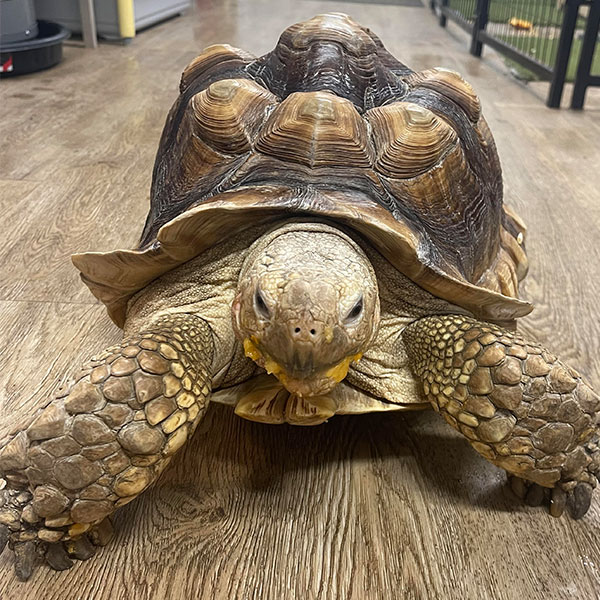
Habitat:
This tortoise can be found in the Sahara Desert and the Sahel (an area of arid savanna and shrubland) in the northern part of central Africa.Adaptations:
These tortoises dig burrows where they will aestivate (or sleep while lowering heart and breathing rate, but not hibernating) and spend time cooling off during the hottest part of the day. When threatened, they will pull their head into their shell and the spurs on their legs help to protect their head.Diet:
Sulcata tortoises require a low-protein, low-moisture diet that is high in calcium. In the wild the diet is mostly comprised of grasses. At the zoo, the tortoise is fed grass, hay or hay flakes, with small amounts of vegetables.Fun Fact:
When African sulcata tortoises are born, they are only about two inches across, but they can grow to be 24-36 inches long and weigh up to 200 pounds. They can live to be up to 150 years old.Status:
Because they are so small as hatchlings, they are often sold as pets with little or no proper care instructions or insight on how big they will get. Sulcata tortoises are listed as vulnerable on the IUCN Red List, and are banned as an import under CITES.Ball Python
Python regius
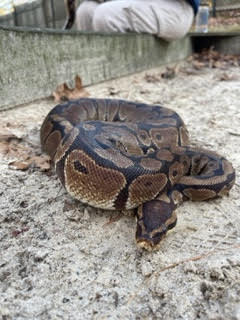
Habitat:
Ball pythons are found on the west coast of Africa and extending into the central part of the continent. The habitat includes grasslands, savannas, brushlands and open or cleared forestland from Senegal to Uganda.Adaptations:
Ball pythons are non-venomous. The average adult length is 3 to 4 feet, and they may grow to 5 or 6 feet in the wild. They are generally brown to black with bold, irregular blotches in light brown, chestnut or yellow; with an off-white underside. Most pythons have limited vision in their eyes and can sense vibrations, but they have no external ears. Pythons have heat-sensitive pits along their jaws that help them detect prey.Diet:
In the wild, ball pythons hunt rodents, small mammals and birds. They have about 150 teeth that are curved inwards to hold prey until the snake can kill them by constriction. At the zoo, the python is fed mice every other week.Fun Fact:
The name "ball python" refers to its tendency to curl into a ball when stressed or frightened.Status:
IUCN Red List Status: Near ThreatenedBarred Owl
Strix varia
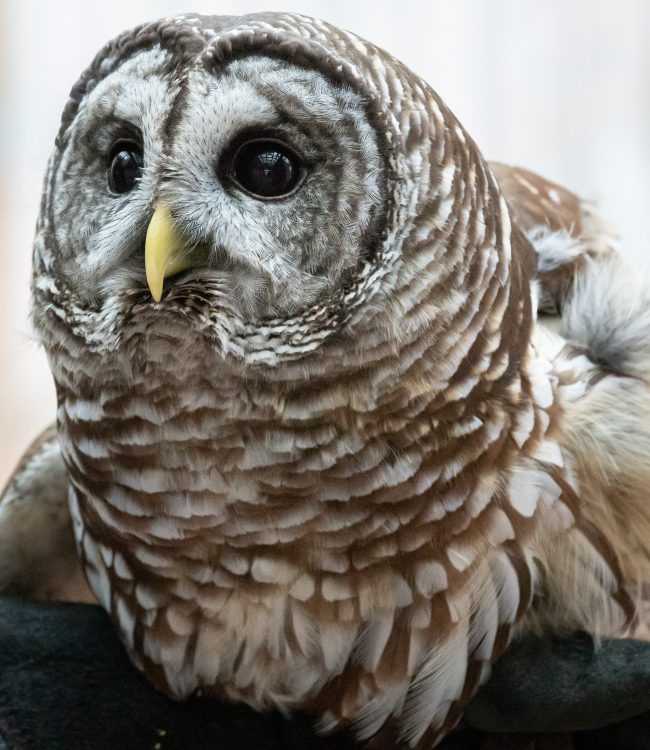
Habitat:
The barred owl frequently lives near bodies of water or marshy wetlands, such as deep swamps or dark, dense woodlands. The two types most frequently used are the oak or mixed woods in the north and the dense forests near swamps in the south.Adaptations:
The barred owl is a medium-sized, round-headed owl with distinct dark streaks on the lower breast and a strongly barred upper breast. This coloration helps camouflage the owl in trees.Diet:
The barred owl mostly eats rodents such as mice and rats, but will also prey on frogs, lizards, small snakes, salamanders, fish, some mollusks, insects and a wide array of birds. At the zoo, their diet consists of mice, chicks or a commercially prepared diet.Fun Fact:
Barred owls are the most vocal of the owls. Their distinctive call consists of two main phases of four to five syllables uttered rhythmically: hoo’-hoo-to-hoo’-ooo, hoo-hoo-hoo-to whoo’oo, which sounds like, “who cooks for you? Who cooks for you all?” The female has a higher-pitched voice than the male.Status:
IUCN Red List Status: Least ConcernBroad-Winged Hawk
Buteo platypterus
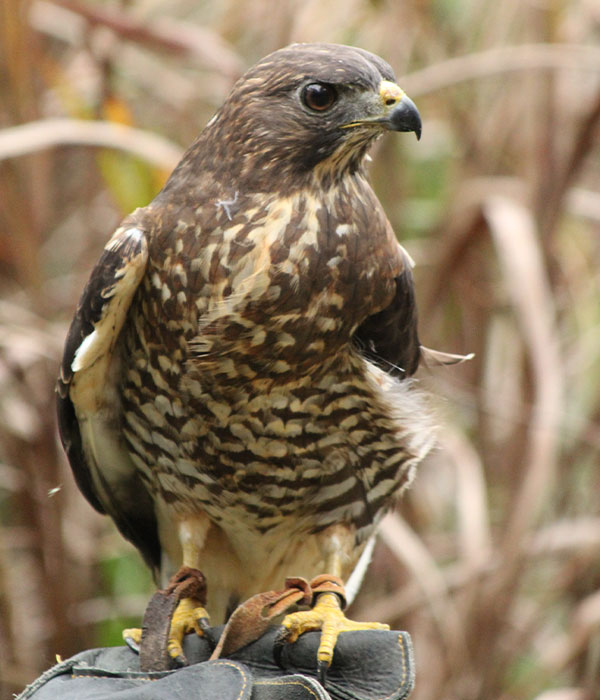
Habitat:
In the summer, broad-winged hawks can be found in deciduous or mixed-deciduous forest from Ontario to Nova Scotia, south to Texas and northern Florida and west to central Alberta, as well as in the Caribbean. In the winter, they can be found in tropical forests from Southern Mexico to South America and in the Caribbean.Adaptations:
Broad-winged hawks hunt by sitting on a branch and waiting for their prey to pass by. They communicate with other hawks visually and vocally. They have four different calls, the most recognized being a whistle sounding like “kee-ee” or “peeowee”Diet:
In the wild, they hunt for small mammals, birds, reptiles and amphibians, and sometimes, large insects, fish and crayfish. In the zoo, the hawk is fed rodents, chicks and a bird-of-prey diet.Fun Fact:
Broad-winged hawks are one of the few North American raptors that migrate in flocks of hundreds of thousands, called kettles. They ride the thermal currents to minimize energy spent on flapping. They migrate about 4,300 miles, covering an average of 70 miles a day.Status:
While their numbers are relatively stable, numbers are declining in some parts of their breeding range due to forest fragmentation. They are protected under the Migratory Bird Act. One subspecies, the Puerto Rican broad-winged hawk, is endangered and protected under the Endangered Species Act. Threats include predation, habitat loss, deforestation and collisions with vehicles.Burrowing Owl
Speotyto cunicularia
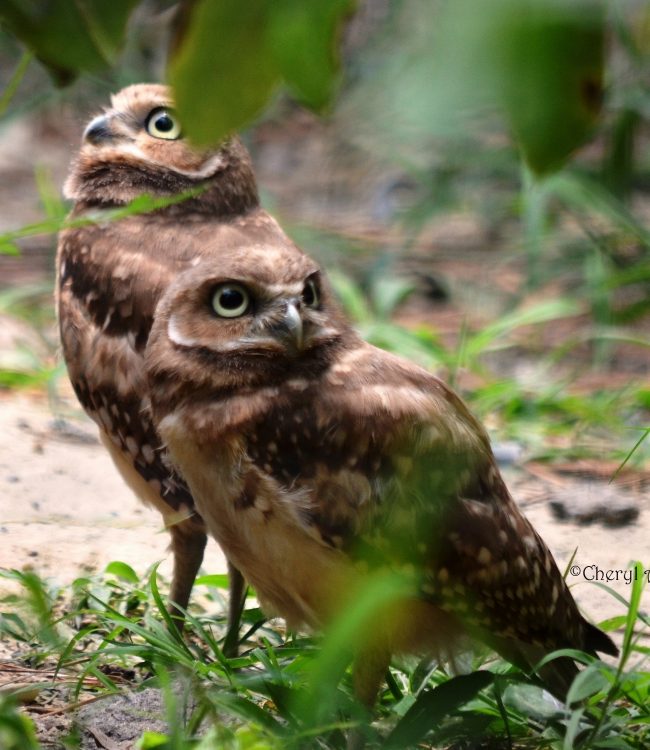
Habitat:
The burrowing owl is found in open country, grasslands, prairies, farmlands, airfields, golf courses and vacant lots. They live in Mexico, Central America, Southern South America and Florida year-round, and for breeding, they live in Western North America an a small portion of Canada. They are capable of digging their own burrow, but most often live in tunnels dug by prairie dogs, gophers, desert tortoises, ground squirrels, and other burrowing animals.Adaptations:
Burrowing owls have long legs, which allow them to hunt on the ground as well as in the air. They live in loose colonies which will warn each other of predators.Diet:
The burrowing owls' diet in the wild consists of insects, small mammals, birds, frogs, snakes and lizards. Unlike many other owls, they will also eat some fruits and seeds. At the zoo, the burrowing owls eat mice, chicks, bird of prey diet, and occasionally, crickets.Fun Fact:
To scare away predators, burrowing owls issue an incredibly accurate vocal mimicry of the rattling of a rattlesnake, accompanied with some hissing sounds.Status:
IUCN Red List Status: Least ConcernCalifornia Tiger Salamander
Ambystoma californiense
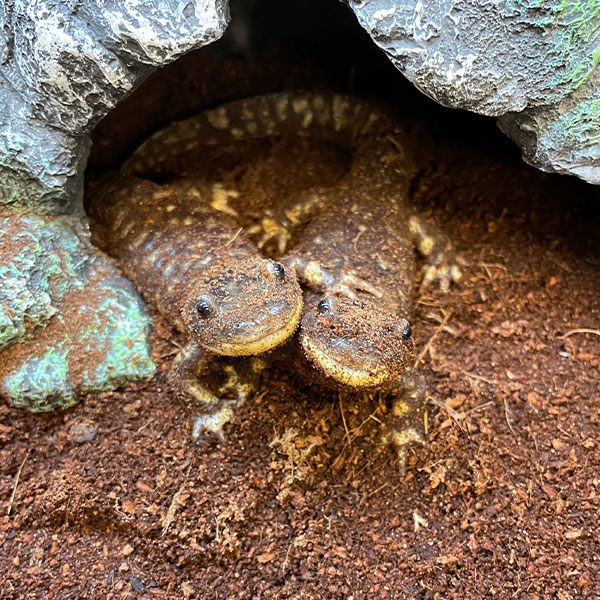
Habitat:
California tiger salamanders are found in Central California. Their habitat includes seasonal wetlands found in wet meadows, seral (or snag) forests and mature conifer forests.Adaptations:
California tiger salamanders have slimy, semi-permeable skin that secretes mucus and allows the animals to absorb moisture. They can regrow limbs and tails that may be lost in encounters with predators.Diet:
In the wild, California tiger salamanders eat earthworms, snails, insects, fish, frogs, toads and small mammals. At the zoo, they are fed crickets and occasionally mealworms.Fun Fact:
Adults spend the majority of their lives underground in burrows created by other animals. This underground phase is referred to as estivation.Status:
IUCN Red List Status: VulnerableChinchilla
Chinchilla lanigera
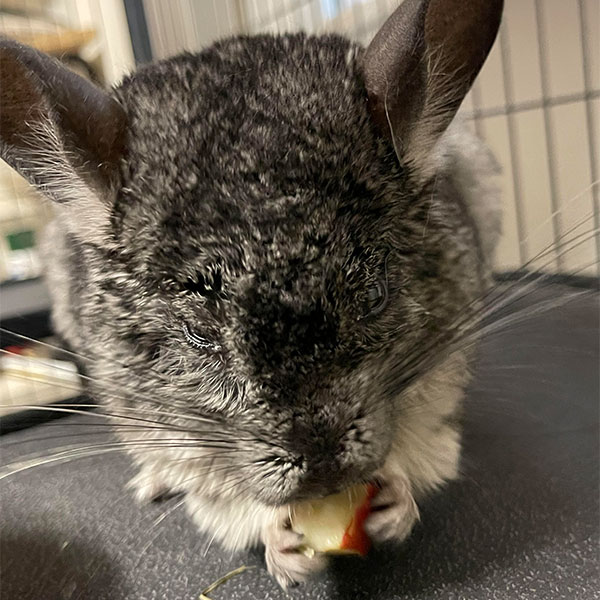
Habitat:
Chinchillas are found in the Andes Mountains of South America. These areas include Chile, Peru, Bolivia and Argentina. They are found at elevations of 9,600-13,000 feet in rocky and relatively barren areas. They live in herds in crevices or holes in the ground or rocks.Adaptations:
A chinchilla's senses are highly developed with large black eyes, long whiskers, a sensitive nose, and large ears. Their rear legs are longer than their forelegs and are used to move the animal like a kangaroo. They also use their forelegs to hold their food.Diet:
In the wild, chinchillas eat any available vegetation. At zoos, they eat alfalfa pellets, fruits and vegetables. Their diet is supplemented with hay.Fun Fact:
Chinchillas have very thick and soft hair. Chinchillas have 60-80 hairs per hair follicle, as opposed to humans, who have just one.Status:
IUCN Red List Status: Endangered In the wild, chinchillas are very rare. Due to public demand for their pelts, chinchillas are found in captivity. Chinchillas are also bred and sold to people as pets around the world.Eastern Box Turtle
Terrapene carolina carolina

Habitat:
Eastern box turtles can be found in the eastern half of the United States, in fields, grasslands, meadows, edge habitats or wooded areas near ponds or streams.Adaptations:
Box turtles have a hard shell that protects them from predators. Their legs are thick and stubby. They have feet that are adapted for living on land; however, they are still slightly webbed. They also have long claws on their feet that help them dig.Diet:
In the wild, they eat small snails, tadpoles, small frogs, earthworms, fruits, berries and leafy green vegetables. At the zoo, they eat apples, lettuce, grapes, bananas, oranges, mealworms, crickets and earthworms.Fun Fact:
Box turtles have a homing instinct, an innate ability to navigate to their home base. This allows them to travel up to 55 yards in one day.Status:
IUCN Red List Status: VulnerableEastern Corn Snake
Elaphe guttata guttata
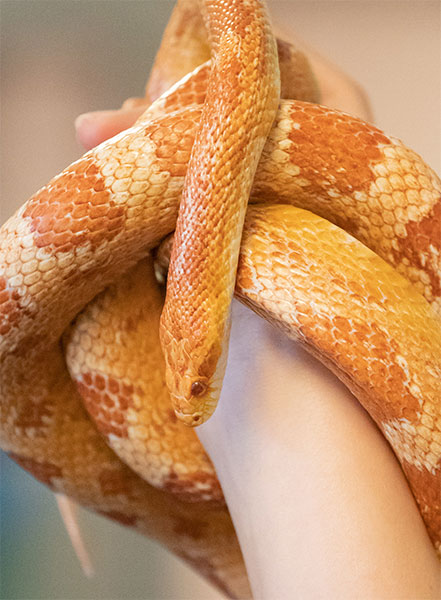
Habitat:
These snakes can be found in wooded groves, rocky hillsides, meadowlands, woodlots, barns, and abandoned buildings. They live in the eastern United States from southern New Jersey to Florida and west to Kentucky and Louisiana.Adaptations:
If threatened, corn snakes will strike repeatedly at an intruder while vibrating their tails. Doing this on dry leaves produces a buzzing sound that resembles a rattle snake, which fools some predators into leaving them alone.Diet:
Corn snakes are constrictors that feed on mice, rats, birds, bird eggs and bats. Hatchlings feed mostly on lizards and tree frogs. They do not eat every day. At the zoo, the corn snake is fed one dead mouse once a week.Fun Fact:
The corn snake at the zoo is an amelanistic or red albino corn snake. It lacks melanin pigment that produces the black coloration of typical corn snakes. This results in an orange, red, and white snake with red eyes.Status:
Corn snakes are listed as endangered in Delaware and as a species of concern in Maryland. They are affected by habitat loss and are often mistaken for copperheads and killed. They are very prevalent in pet trade because of their coloration, but most sold as pets are bred in captivity.Eastern Painted Turtle
Chrysemys picta
Habitat:
Eastern painted turtles are found in freshwater habitats that have soft bottoms, adequate basking sites and ample aquatic vegetation. This includes rivers, streams, ponds, impoundments, open-water marshes and vernal pools. They can be found in eastern North America from Nova Scotia south to Georgia, but only as far west as the Appalachian Mountains.Adaptations:
These turtles' flat shells and webbed feet allow them to easily swim through water. They have special organs called "barbels" that allow them to smell underwater, which is important for locating food. Painted turtles use their feet to help catch the food and their sharp beaks to tear it apart.Diet:
In the wild, the eastern painted turtle eats aquatic vegetation and invertebrates. They sometimes feed on frogs and fish but mostly when they are already dead. At the zoo, the turtle is fed aquatic turtle food and smelts.Fun Fact:
Eastern painted turtles can be observed basking on logs on Delmarva. The sex of an eastern painted turtle is determined by the temperature of the eggs, with cooler temperatures creating more males and warmer temperatures creating more females.Status:
IUCN Red List Status: Least ConcernEastern Spiny Softshell Turtle
Apalone spinifera
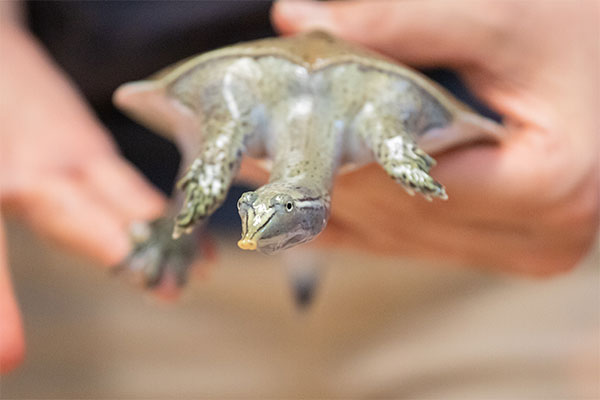
Habitat:
Eastern spiny softshell turtles live in rivers, ponds or streams, or along the shorelines of large lakes with sandy or muddy bottoms and vegetation. They can be found from Georgia to Texas, up toward Minnesota and east to western New York. These turtles can also be found in western Virginia and southern North Carolina.Adaptations:
Softshell turtles are yellowish-brown with small black spots on their carapaces (upper shells). They have soft, leathery shells that lack scales or scutes. They have long necks that can reach up to six inches, and long, tubular snouts. They have webbed feet, sharp claws and sharp beaks. Males are about 5-9 inches long and females are about 7-17 inches long.Fun Fact:
Softshell turtles are excellent swimmers and can also be quick on land. They can stay submerged underwater for hours at a time because they can absorb dissolved oxygen through their skin and a special lining in their throat and cloaca (part of their digestive tract). Unlike other turtles, the temperature of the eggs does not determine the sex.Status:
IUCN Red List Status: Least ConcernGopher Tortoise
Gopherus polyphemus
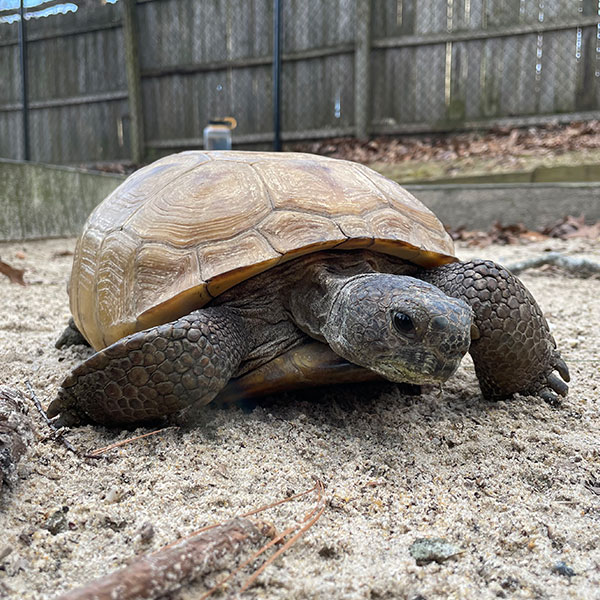
Habitat:
Gopher tortoises live in Florida, along with the southern areas of Georgia, South Carolina, Mississippi, Alabama and the tip of Eastern Louisiana. They are one of five North American tortoises and the only tortoise east of the Mississippi River. They live in well-drained, sandy soils in longleaf pine sandhills, xeric oak hammocks, pine flatwoods, dry prairies, coastal dunes, loblolly forests and maritime forests.Adaptations:
Gopher tortoises can grow to be about 9-11 inches long, with shovel-like forelimbs for digging. They have a large, domed shell and small, hard scales on their legs.Diet:
In the wild, gopher tortoises eat grasses, berries, fruit and occasionally carrion. In the zoo, the tortoise eats lettuce, hay, certain fruits and vegetables and a special tortoise diet made of grasses.Fun Fact:
Gopher tortoises can live up to 70 years in the wild and up to 100 in captivity. The sex of gopher tortoises' offspring is determined by the temperature of the sand or dirt where the nest is incubating. If the temperature is above 30 degrees Celsius (85 degrees Fahrenheit), the tortoise hatchlings will be female. If the temperature is below 30 degrees Celsius, the hatchlings will be male.Status:
IUCN Red List Status: VulnerableGreat Horned Owl
Bubo virginianus
Habitat:
Great horned owls live in North and Central America year-round, along with northern and eastern parts of South America.Adaptations:
Great horned owls see well in broad daylight, but their eyes are better adapted than the eyes of other birds and most animals for seeing in dim light. The vocal call is hollow, soft and booming; a “hoo-hoo-hoooooo-hoo-hoo," otherwise known as a “five hooter.” Their sense of smell is very poor, so they can prey on a skunk that has just sprayed and not smell it.Diet:
In the wild, great horned owls eat rabbits, squirrels, birds (other owls, ducks, hawks and geese), skunks, opossums, woodchucks, lizards, frogs and snakes. In the zoo, the great horned owl eats a commercially prepared bird of prey diet, chicken, mice and an occasional rat.Fun Fact:
The call of the great horned owl is the one often heard in "dark night" scenes on TV. When clenched, it takes 28 pounds of force to open their talons. Great horned owls' strong grip allows them to sever the spines of large prey.Status:
IUCN Red List Status: Least ConcernGuinea Pig
Cavia porcellus
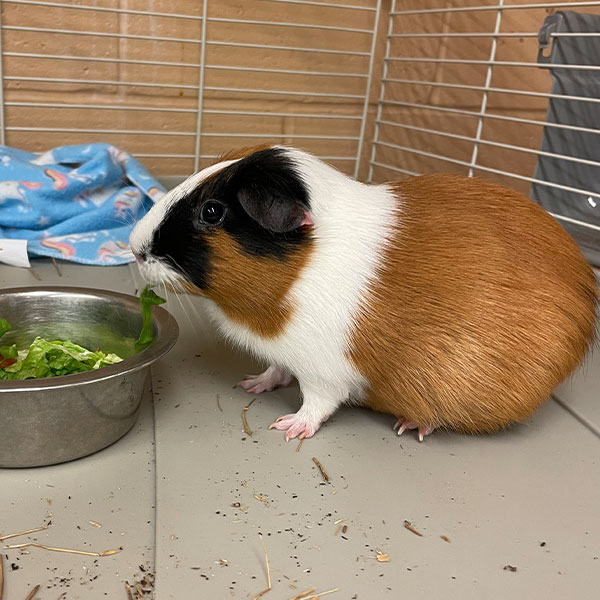
Habitat:
Guinea pigs enjoy open areas, ranging from moist savannas to thorn forests and scrub deserts. They can be found in both low and high elevations and in marshes, rocky areas and grasslands. Guinea pigs can be found throughout South America, from Venezuela to southern Patagonia, but not in Chile or the Amazon River basin.Adaptations:
Guinea pigs' incisors continuously grow. They must gnaw on wood or plant material to keep their teeth the proper length. Cavies have rootless molars. They are social animals that live in large groups, and they are also vocal animals.Diet:
In the wild, guinea pigs eat available vegetation -- mostly greens, root vegetables and hay. At the zoo, they eat a special pellet diet, fresh fruits, and vegetables.Fun Fact:
The "pig" in their popular name comes from the fact that these small animals are round and plump like a pig, and they have a pig-like squeal. One theory behind its origin is that guinea pigs were brought to Europe by way of Guinea (in Africa) and people thought they originated there. "Guinea" was also used in the English language to reference a far-off, unknown or exotic place.Status:
Wild guinea pigs still exist, four are listed as least concern and two are critically endangered. However, guinea pigs have been domesticated for so long that the ones that people have as pets are now considered a different species.Harris Hawk
Parabuteo unicinctus
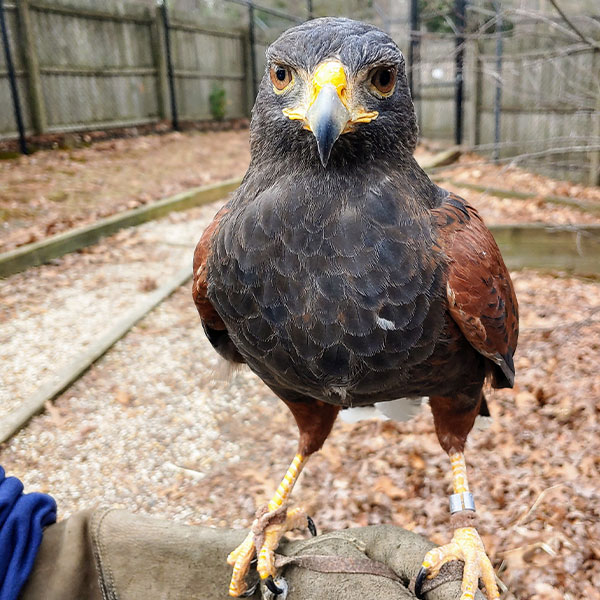
Habitat:
This species of hawk is found in Southern Arizona, New Mexico, Central Texas, Southern California, Mexico, and Central and South America.Adaptations:
Harris hawks are 18-24 inches long, with a wingspan of 38-43 inches. They weigh about 1.5-2.5 pounds. They are dark brown with coppery wings, a while patch on the rump and a white tail tip. The eyesight of Harris hawks is thought to be eight times better than that of humans, with sensors that enable them to zoom in and out. Harris hawks hunt in groups of three to five family members, which allows them to go after larger prey.Diet:
In the wild, Harris hawks eat rodents, reptiles, insects and smaller birds. Larger animals such as rabbits can be hunted in groups, and they will also eat carrion if available. In the zoo, they eat mice, rats, chicks and a bird-of-prey diet.Fun Fact:
Harris hawks are named after naturalist Edward Harris and former names include a bay-winged hawk and dusty hawk. Harris hawks have been observed doing something called "stacking," in which one perches on a cacti and two to three birds perch on their back, to see prey and predators.Status:
Harris hawks are not listed as threatened or endangered, but they are still protected under the Migratory Bird Treaty Act.Predators:
Coyotes and bobcatsMerlin
Falco columbarius
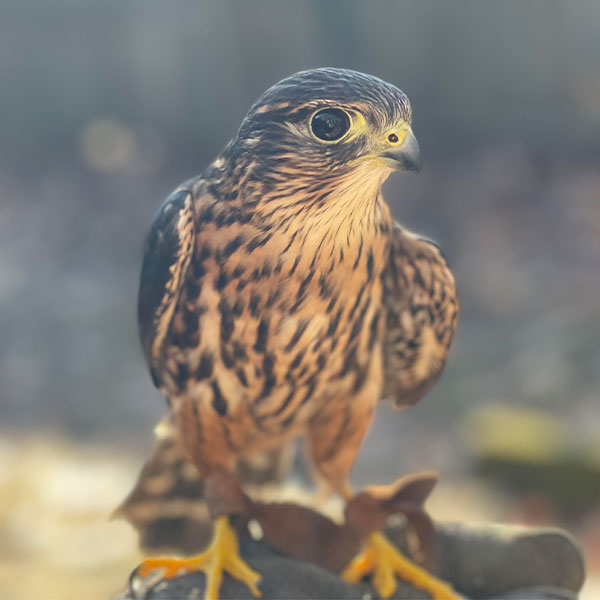
Habitat:
Merlins prefer semi-open areas and make nests by forested openings near rivers, lakes, bogs, lake islands, prairie groves, foothills, marshes and open conifer woodland. They may spend the winter in grasslands and coastal marshes. During breeding season, they can be found in Canada, Alaska and New England. Then, they move south -- mostly west of the Mississippi River, but also in the southeast United States, Mexico and Central and South America.Adaptations:
Merlins often seize nests from other larger birds like crows or hawks instead of building their own. They typically fly at speeds of 30 mph or higher if they are chasing prey.Diet:
In the wild, they eat small songbirds, nestling birds, bats, dragonflies and small mammals. At the zoo, the merlin eats mice, chicks and a bird of prey diet.Fun Fact:
During breeding season, they are monogamous, but most merlins find a new mate from year to year. Male merlins perform a spectacular display when courting a female, including rocking side to side, making deep U-shaped dives and slow fluttering flights.Status:
IUCN Red List Status: Least ConcernMerlins are protected under the Migratory Bird Treaty Act.
Red-Tailed Hawk
Buteo jamaicensis
Habitat:
Red-tailed hawks are commonly found in a wide variety of habitats, such as woodlands, alpine meadows and deserts, in North America, Central America and the Caribbean. They are not found in dense forests or arctic regions.Adaptations:
They have excellent eyesight, about eight times better than that of humans, which they use for hunting. They can dive for prey at speeds of 100-120 mph. They are not migratory, but will relocate seasonally to ensure a plentiful food supply.Diet:
In the wild, red-tailed hawks hunt for small mammals, rodents, rabbits, small birds, frogs, bats and reptiles. They also catch fish and large insects. They are known to steal prey from other raptors and eat carrion. In the zoo, they eat mice, rats, chicks and bird-of-prey food.Fun Fact:
The raspy call of a red-tailed hawk is often used in movies or on TV to represent any type of hawk or eagle. Red-tailed hawks' nests can be found up to 120 feet above ground, and both parents incubate the eggs.Status:
IUCN Red List Status: Least ConcernSun Conure
Aratinga solstitialis
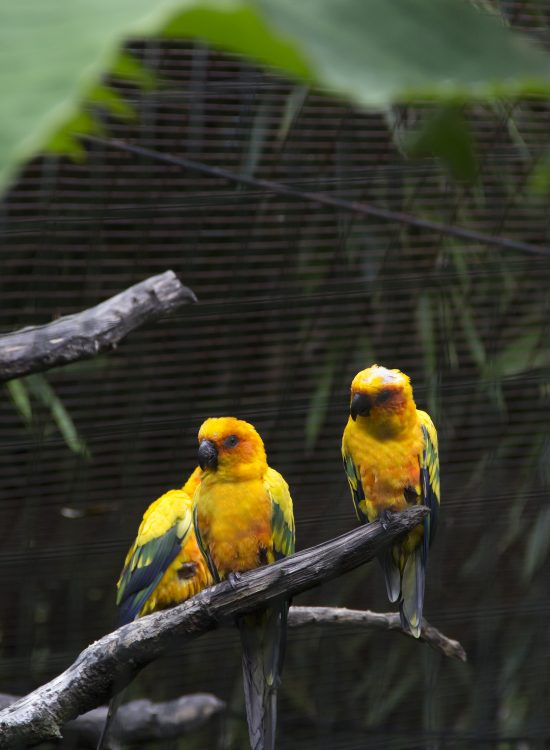
Habitat:
Sun conures are found in open savannas or within dry savanna woodland. They are also found in scrubland along the Amazon riverbank, forested valleys, and coastal and seasonally flooded forests.Adaptations:
Sun conures are mainly yellow and orange or orange-red, with a tapered and graduated green tail. The voice of the sun conure is high-pitched and unclear. They usually travel in flocks of 20-30 in the wild and produce loud squawks and screams.Diet:
In the wild, they eat nuts, fruit, vegetables and berries. At zoos, they eat a special parrot diet, varied fruits and vegetables, peanuts, and occasionally tree nuts.Fun Fact:
Conures won't eat anything new unless they see another bird eat it first. They can use their beaks as a "third foot" when climbing.Status:
IUCN Red List Status: Endangered. This is primarily because of destruction of their habitat and exportation.Turkey Vulture
Cathartes aura
Habitat:
Turkey vultures can live in habitats including forests, fields, deserts, open country and wetlands. They mainly live in or near deciduous forests and woodlands and are often seen over adjacent farmlands. They live in the southern United States, Mexico and Central and South America year-round and can be found in southern Canada and the United States for breeding.Adaptations:
Turkey vultures have a well-developed sense of smell and although they have keen eyesight, they can locate food by odor alone. The vulture's beak has a nostril that goes all the way through the beak. The vulture's bald head enables it to stick its head into carcasses without getting its feathers messy. They don't get sick from eating rotten meat because their digestive juices kill bacteria. They can defecate on their feet to cool them off or to serve as an antiseptic wash.Diet:
Turkey vultures eat animals that have recently died and occasionally kill newborn pigs and baby herons and ibis in rookeries. At the zoo, the turkey vulture eats chicks, mice, rats and bird of prey food.Fun Fact:
When threatened, turkey vultures will regurgitate their last meal and send it sailing 10 feet. The smell alone will scare many potential threats away. A group of turkey vultures will often roost together in one tree, and over time, their acidic feces will eventually kill the tree. Turkey vultures mate for life.Status:
IUCN Red List Status: Least ConcernUmbrella Cockatoo
Cacatua alba
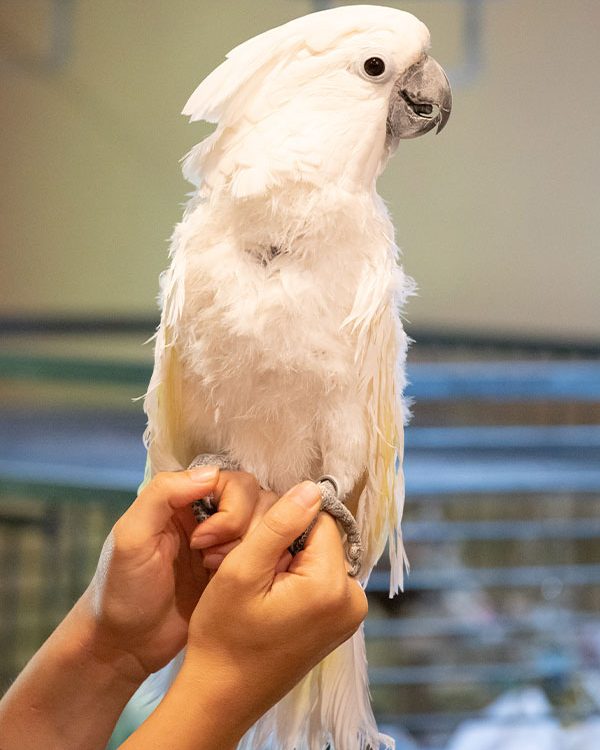
Habitat:
The umbrella cockatoo is found in forest, woodlands, edge habitats near clearings and rivers, mangroves, swamps and agricultural areas. They are found throughout Southeast Asia and Australia.Adaptations:
Umbrella cockatoos have white feathers that are very dusty. These dusty feathers provide these birds with some waterproofing in their native habitat. These birds are excellent climbers and can use their beak as an extra "foot."Diet:
In the wild, cockatoos eat nuts, fruit, vegetables, berries, and occasionally skinks and large insects. At zoos, cockatoos eat a pelleted parrot diet, fruits, vegetables and occasionally peanuts and other nuts.Fun Fact:
Umbrella cockatoos form very strong pair bonds. Because of this, they will often have the same mate for their entire lives.Status:
IUCN Red List Status: Endangered. Many species of cockatoos are threatened by over-collection for the pet trade, deforestation, hunting and habitat loss.American Black Duck
Anas rubripes
Habitat:
The American black duck can be found in the eastern half of the United States and Canada, in wetlands and coastal areas.Adaptations:
While this type of duck isn't the best flyer, it is a great swimmer and diver. Although they feed along the surface of the water, they can dive more than 12 feet underwater.Diet:
These animals' diet is primarily made up of plants, but during breeding season, American black ducks also eat insects and other small animals, such as mollusks.Fun Fact:
The female black duck uses her feathers as part of the material that covers her eggs in her nest.Although its name is the American black duck, this species is actually dark brown.
Status:
IUCN Red List Status: Least ConcernAmerican Crow
Corvus brachyrhynchos
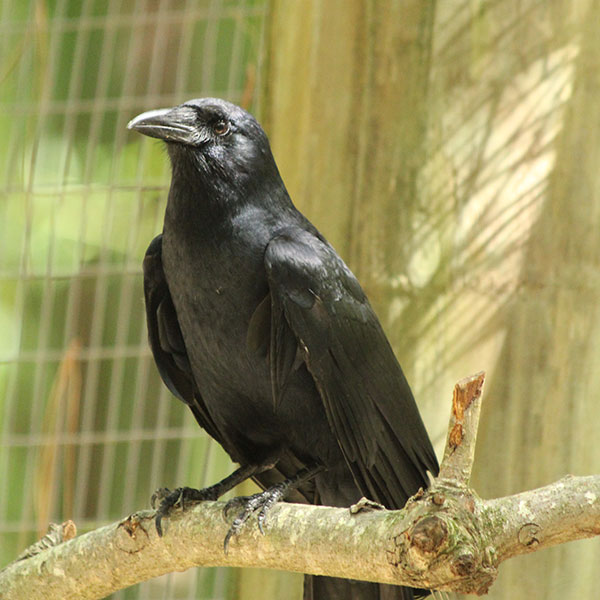
Habitat:
American crows are found in North America, from Canada to northern Mexico. They are found in open habitats, such as meadows, farmland and open woodland. Northern crows may migrate south in the winter; southern crows do not.Adaptations:
American crows are very social, sometimes forming flocks in the thousands. Their flight style is unique, a patient, methodical flapping that is rarely broken up with glides. The most usual call is "CaaW!-CaaW!-CaaW!"Diet:
Crows are opportunistic, and they will eat several kinds of food, including insects, earthworms, fruit, seeds, reptiles, eggs and rodents. In towns and cities, they quickly learn to associate people with food and will scavenge garbage.Fun Fact:
Inquisitive and sometimes mischievous, crows and their cousins, the ravens, jays and magpies, are some of the most intelligent of all birds. They learn quickly and are excellent problem solvers, even learning how to use tools in some cases.Status:
IUCN Red List Status: Least ConcernThe American crow is one of the most common songbirds in North America. They are protected under the Migratory Bird Treaty Act of 1918.
American Flamingo
Phoenicopterus ruber
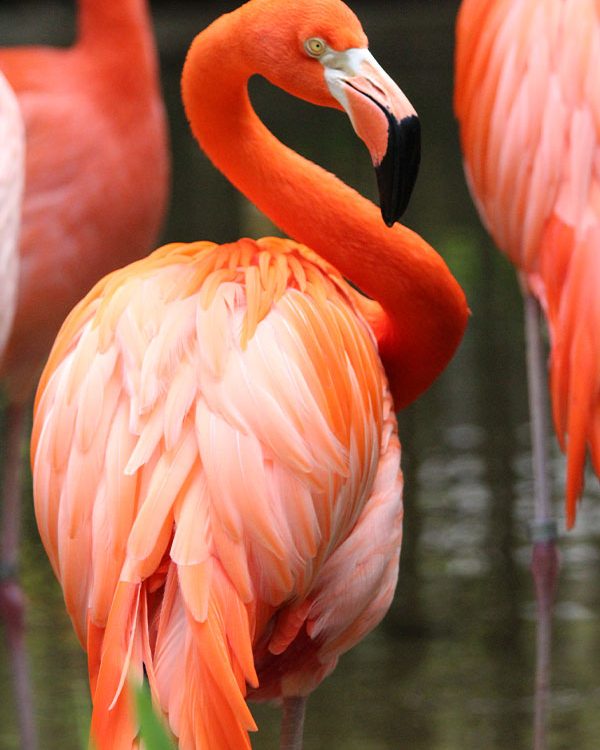
Habitat:
American flamingos are found in central and northern South America. They also live on several Caribbean islands, as well as the Galapagos. They live in lagoons, estuaries, mud flats and lakes.Adaptations:
Flamingos are filter-feeders, sweeping their curved bills through the water with their heads held upside down. The bill filters the water and mud, and the bird swallows the prey. Their tongue and beak have comb-like filaments that act as filters when feeding.Diet:
Flamingos eat diatoms (minute planktonic unicellular or colonial algae), blue-green algae, mollusks and crustaceans. Flamingos, which are born gray, obtain their famous pink color from the food that they eat.Fun Fact:
Flamingos often mate for life, working together to build tall mud nests in which they lay their single egg. Flamingos nest in enormous colonies; it is believed that they require the presence of large groups of other flamingos to feel comfortable enough to breed.Status:
IUCN Red List Status: Least ConcernBald Eagle
Haliaeetus leucocephalus
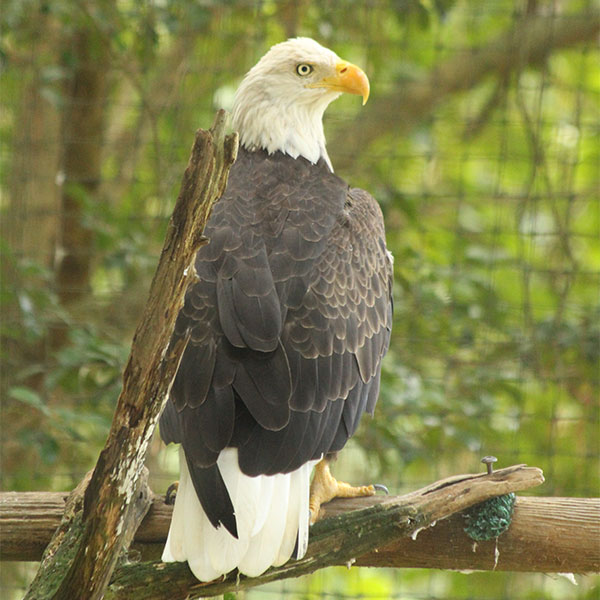
Habitat:
The bald eagle makes its home in forested areas near the water, including marshes, coastlines and riverbanks. The national bird of the United States, they are also found in Canada and northern Mexico. Vagrant bald eagles have been found as far abroad as Ireland.Adaptations:
The eagle’s eyes are set close together, giving them binocular vision, which gives them excellent depth perception. Eagle vision is estimated to be up to eight times better than human vision. An eagle’s ears are located under a layer of feathers just behind the eyes. Eagles have hooked beaks designed to cut, tear and crush their food. Eagles have strong legs and powerful bright yellow feet, which help them catch their prey and also allow them to perch high in the treetops.Diet:
Mainly fish, also rodents, small mammals and carrion (dead animals).Fun Fact:
Bald eagle nests, built of woven sticks, are among the largest of bird nests, and they may be reused and added to for years. Bald eagles do not obtain their characteristic white head until they are mature, usually at 5 years old. Despite their fierce appearance, the voice of the bald eagle is very weak, sounding more like a chicken’s cluck. The “scream” of a bald eagle often heard in movies and television is usually the call of a red-tailed hawk. The Salisbury Zoo's two bald eagles, Cheveyo and Sam, are both non-releasable and non-flighted. Before they came to the Zoo, they had each been injured.Status:
IUCN Red List Status: Least Concern Once common across North America, the population suffered a tremendous decline, largely due to the pesticide DDT, which resulted in weak, deformed eggshells. Since the banning of DDT in 1972, bald eagles have rebounded and were removed from the Endangered Species Act federal listing in 2007.Barrow’s Goldeneye Duck
Bucephala islandica
Habitat:
Barrow's goldeneye ducks live along the west coast of the United States, the northwestern area of the country around the Rocky Mountains, western Canada and Alaska. They can also be found in eastern Canada, Maine and Iceland. They live in forests, wetlands and coastal areas.Adaptations:
Males have several displays they use when interested in mating with a female. The female is responsible for choosing a nesting area and creating the nest.Diet:
This type of duck feeds on aquatic invertebrates and dives underwater to catch its prey.Fun Fact:
This type of duck looks similar to the common goldeneye, but there are differences for those who look closely.Status:
IUCN Red List Status: Least ConcernBlack-Crowned Night Heron
Nycticorax nycticorax
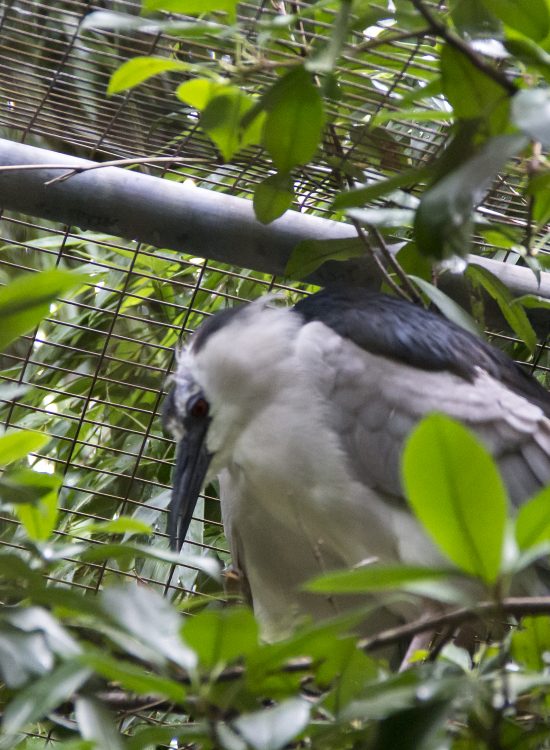
Habitat:
Black-crowned night herons are found almost worldwide, from North and South America to Eurasia and Africa. They live in wetlands, mangrove swamps, and coastal areas.Adaptations:
As their name suggests, night herons are often inactive by day and can be found roosting in trees. During the breeding season, when their demand for food is higher, they may hunt during both day and night. They are very vocal, with their most common call being a harsh croak.Diet:
Black-crowned night herons eat fish, aquatic invertebrates, amphibians, reptiles and small mammals.Fun Fact:
This species' scientific name means “night raven,” since they are nocturnal and have a crow-like call.Status:
IUCN Red List Status: Least Concern This species is protected under the U.S. Migratory Bird Act.Blue-Throated Macaw
Ara glaucogularis
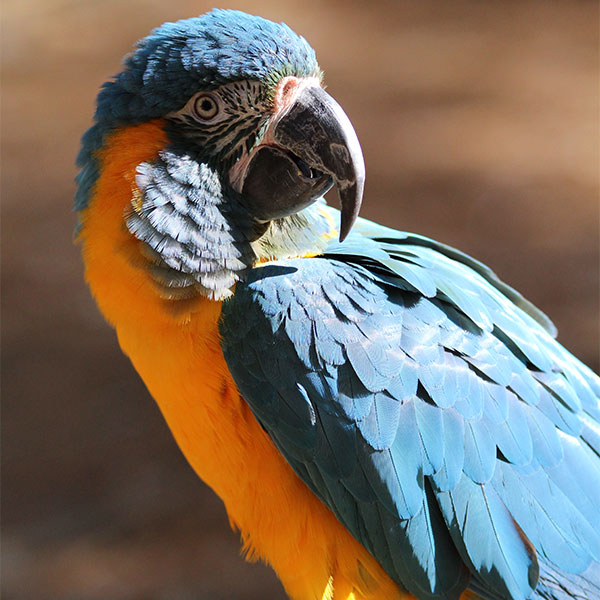
Habitat:
Blue-throated macaws can be found living in Bolivia's tropical savannas.Adaptations:
They are smart birds, and if they sense danger, they will produce a loud sound.Diet:
These animals eat fruit that comes from palm trees.Fun Fact:
Blue-throated macaws mate for life. In Spanish, this bird's name is "paraba barba azul," which means "blue-bearded macaw."Status:
IUCN Red List Status: Critically EndangeredBurrowing Owl
Speotyto cunicularia

Habitat:
The burrowing owl is found in open country, grasslands, prairies, farmlands, airfields, golf courses and vacant lots. They live in Mexico, Central America, Southern South America and Florida year-round, and for breeding, they live in Western North America an a small portion of Canada. They are capable of digging their own burrow, but most often live in tunnels dug by prairie dogs, gophers, desert tortoises, ground squirrels, and other burrowing animals.Adaptations:
Burrowing owls have long legs, which allow them to hunt on the ground as well as in the air. They live in loose colonies which will warn each other of predators.Diet:
The burrowing owls' diet in the wild consists of insects, small mammals, birds, frogs, snakes and lizards. Unlike many other owls, they will also eat some fruits and seeds. At the zoo, the burrowing owls eat mice, chicks, bird of prey diet, and occasionally, crickets.Fun Fact:
To scare away predators, burrowing owls issue an incredibly accurate vocal mimicry of the rattling of a rattlesnake, accompanied with some hissing sounds.Status:
IUCN Red List Status: Least ConcernChiloe Wigeon
Mareca sibilatrix
Habitat:
In South America, the chiloe wigeon is a duck typically found on lakes, lagoons, slow-flowing rivers and other freshwater bodies. They breed in the most southern parts of South America and migrate throughout central South America.Adaptations:
This duck has an attractive pattern of black and white on its body, chestnut flanks, and a green band from its eye to the back of its neck. Its beak is usually blue-grey.Diet:
The chiloe wigeon feeds on aquatic vegetation from the water's surface by dipping its head. This bird will also graze from land.Status:
IUCN Red List Status: Least ConcernCommon Eider
Somateria mollissima
Habitat:
Common eiders live in oceans and make their nests on islands and shorelines. The animals breed in arctic regions.Adaptations:
Common eiders are sea ducks that dive for their food.Diet:
Mollusks make up a big part of this species' diet.Fun Fact:
The common eider can be nearly six pounds and more than two feet long, making it the biggest duck found in the northern hemisphere.Status:
IUCN Red List Status: Near ThreatenedFlorida Sandhill Crane
Grus canadensis pratensis
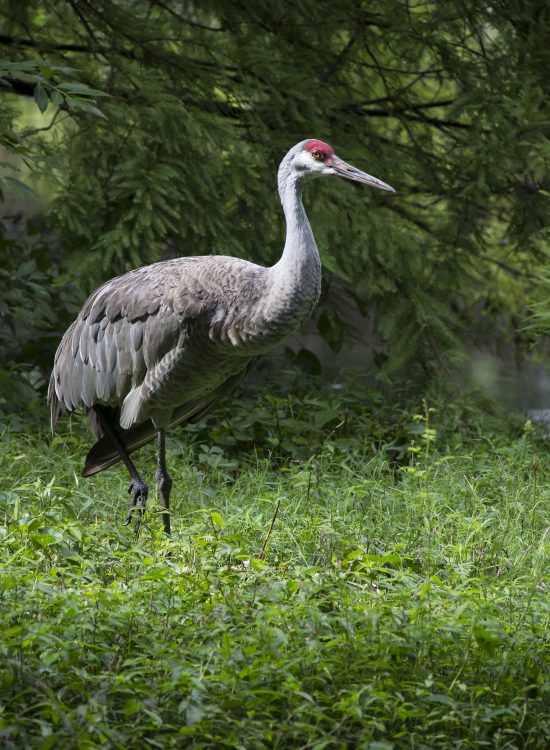
Habitat:
Florida sandhill cranes live in areas including freshwater marshes, prairies and pastures. They can be found in urban and suburban areas in Florida and southern Georgia.Adaptations:
While other types of sandhill cranes are migratory, Florida sandhill cranes are not. Florida sandhill cranes fly with their necks fully stretched out. The head of this species features a red bald spot.Diet:
Sandhill cranes are omnivores, and they eat seeds, grains, berries, insects, earthworms and small animals such as mice, frogs and crayfish.Fun Fact:
The sound of a sandhill crane can travel for up to two miles. These animals mate for life.Status:
This species is not ranked by IUCN or federally, but it is designated as threatened in Florida. It is also protected by the U.S. Migratory Bird Treaty Act.Greater Rhea
Rhea americana
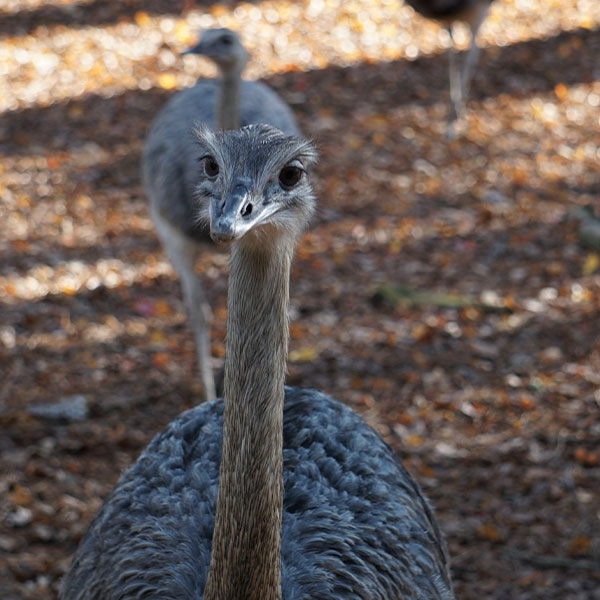
Habitat:
Greater rheas inhabit the grasslands and open woodlands of southeastern South America.Adaptations:
Rheas are members of the ratite family, the group of flightless birds that also includes the ostrich, emu, cassowary and kiwi. Though they cannot fly, they are excellent runners, possessing long, featherless legs and three toes. The birds speed away at the first sign of danger, using their wings as rudders when they change direction.Diet:
Rheas eat grasses, insects, roots, leaves, seeds and small vertebrates.Fun Fact:
A female rhea’s involvement with her eggs ends the moment they hit the ground. Several females will lay their eggs in a shared nest, which will then be incubated and guarded by the male. After the eggs hatch, the male cares for the young by himself.Status:
IUCN Red List Status: Near Threatened Rheas are sometimes hunted for their meat, eggs, and skin. They are also persecuted by farmers who view them as competitors with their livestock. Habitat loss – especially caused by livestock grazing and fences – is also a threat.Green-Winged Macaw
Ara chloropterus
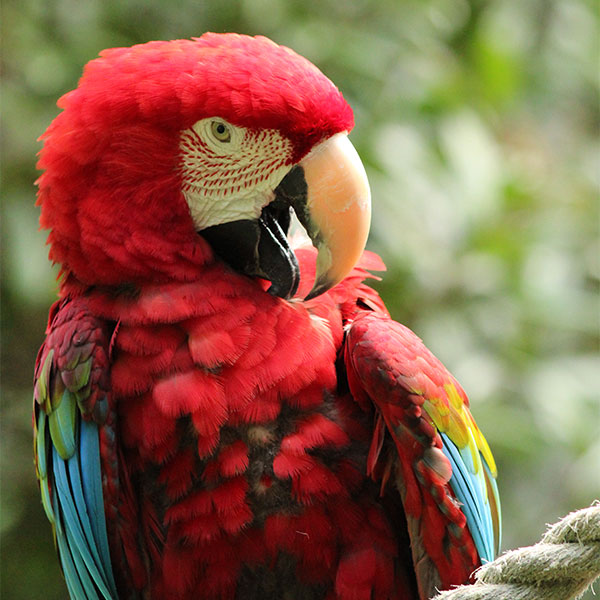
Habitat:
Macaws are a group of long-tailed, large-beaked parrots native to Central and South America. Across that range, they live in several kinds of forested habitats, from dense tropical rainforest to dry, wooded savanna.Adaptations:
Macaws' large, strong beaks are useful for feeding and climbing. Macaws travel together in loud screeching flocks.Diet:
Macaws eat seeds, nuts and fruits.Fun Fact:
Macaws are messy eaters, dropping large quantities of food as they eat. In the wild, this habit provides many ground-dwelling animals with fruit they would not otherwise be able to reach. Some of the foods macaws eat in the wild contain small amounts of toxins. To counter these poisons, macaws will eat clay, gathering in large numbers on cliff faces to obtain it. Green-winged macaws are the second-largest type of macaw.Status:
IUCN Red List Status: Least ConcernHooded Merganser Duck
Lophodytes cucullatus
Habitat:
This type of duck can be found in much of the United States and southern Canada, in forests, wetlands and coastal areas.Adaptations:
Hooded mergansers' eyes allow them to see well underwater. Ducklings are able to get their own food when they are just a day old.Diet:
Hooded mergansers have a wide range of animals in their diet, including small fish, aquatic insects, crayfish and more. They also eat plants.Fun Fact:
These ducks can be recognized by their "hoods" -- puffed out feathers on their heads.Status:
IUCN Red List Status: Least ConcernLaughing Kookaburra
Dacelo novaeguineae
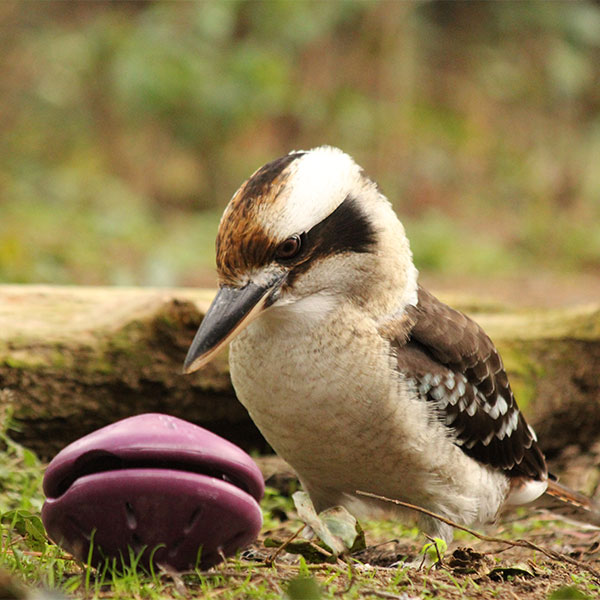
Habitat:
Laughing kookaburras are native to eastern Australia, though they have also been introduced to southwest Australia, Tasmania and New Zealand. They live in woodland and open forests.Adaptations:
The laughing kookaburra is the largest member of the kingfisher family. They are best known for their wild, raucous call, when sounds like crazed laughter. In actuality, it’s a territorial call. Their tendency to call most frequently at dawn and dusk has given them the nickname of “bushman’s clock."Diet:
Kookaburras mostly eat insects, worms and crustaceans, but will also take larger prey – small mammals, frogs, birds and snakes. Lacking the talons that birds of prey possess, kookaburras will kill larger prey animals by whacking them repeatedly against a branch or the ground.Fun Fact:
Kookaburras are bold and curious, and readily come to associate people with food. They’ve even been known to swoop down and snatch food right out of people’s hands.Status:
IUCN Red List Status: Least ConcernLesser Scaup
Aythya affinis
Habitat:
Lesser scaup ducks live in the United States, Canada and Mexico, and they can be found in numerous other countries as well. Habitats include wetlands and coastal areas.Adaptations:
These ducks are social animals who dive for their food. In migration, they lag behind other animals when both moving south and north.Diet:
These animals' main source of food is aquatic invertebrates.Fun Fact:
Female ducks of this species lay their eggs before they are done building their nests. According to The Cornell Lab, this species is North America's most commonly found diving duck.Status:
IUCN Red List Status: Least ConcernMasked Lapwing
Vanellus miles
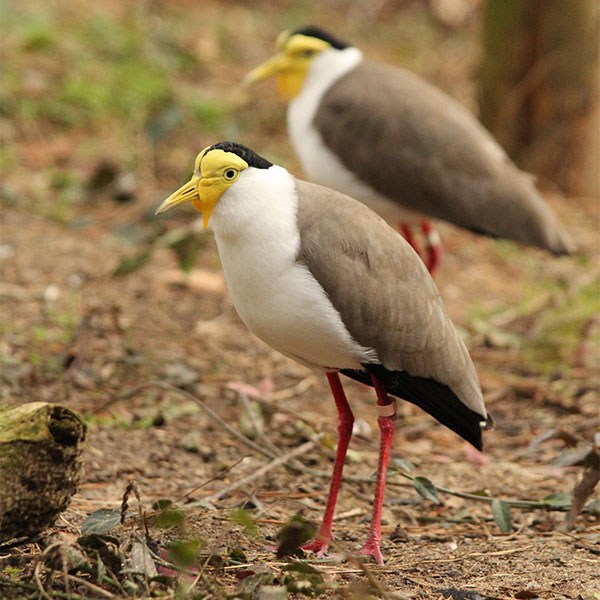
Habitat:
Masked lapwings can be found in Australia and parts of surrounding countries. They live in wetlands, farmland, pastures and urban areas.Adaptations:
These birds' wings each have a thorny spur.Diet:
Masked lapwings eat insects.Fun Fact:
This species will firmly defend its nests against potential predators.Status:
IUCN Red List Status: Least ConcernPuna Teal
Spatula puna
Habitat:
This type of duck lives in wetlands that are part of the Andes Mountains in South America.Adaptations:
Puna teals live in high-altitude areas. It is a type of dabbling duck.Diet:
Puna teals eat aquatic animals, plants and seeds.Fun Fact:
Before it became its own species, this type of duck was a subspecies of the silver teal.Status:
IUCN Red List Status: Least ConcernRing-Necked Duck
Aythya collaris
Habitat:
Ring-necked ducks can be found in places including wetlands, marshes and ponds in North America.Adaptations:
Ring-necked ducks dive for their food.Diet:
This species of duck eats aquatic plants and invertebrates. Animal sources are key during breeding season.Fun Fact:
This duck's name comes from a brown-colored ring around the neck that people may not be able to see, especially from a distance.Status:
IUCN Red List Status: Least ConcernRinged Teal
Callonetta leucophrys
Habitat:
Ringed teals live in central South America in tropical forests and wetlands.Adaptations:
Ringed teal are a type of wood duck and are a small species, at about just over a foot in length.Diet:
This animal eats aquatic plants, along with insects and other small aquatic animals.Fun Fact:
When this duck walks, it can look like it is limping.Status:
IUCN Red List Status: Least ConcernSpectacled Owl
Pulsatrix perspicillata
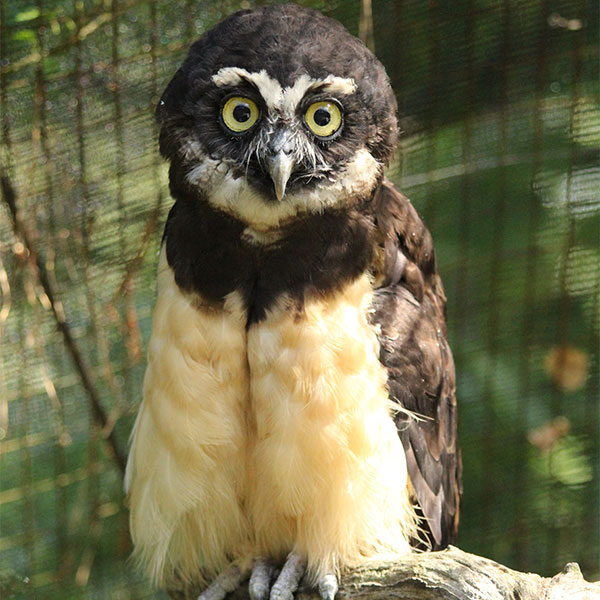
Habitat:
The range of the spectacled owl reaches from southern Mexico down into the central part of South America. They live in thick, humid rain forests and wooded grasslands.Adaptations:
As with most raptors, the female is larger than the male; this allows the male and female to share a territory while catching different prey animals. Spectacled owls have an unmistakable face pattern. Light circles around their yellow eyes give them the appearance of wearing glasses or spectacles, which is how they got their name. Chicks and juveniles, on the other hand, are white with brown markings on their faces.Diet:
Spectacled owls eat small mammals, birds, frogs and insects.Fun Fact:
Although they are usually active at night, they will sometimes hunt during the day. Spectacled owls have several calls, including a series of popping, tapping sounds, which has given them the nickname of “knocking owl."Status:
IUCN Red List Status: Least ConcernSpotted Whistling Duck
Dendrocygna guttata
Habitat:
Spotted whistling ducks can be found on ponds, fresh marshes and freshwater lakes. In the United States, they range from Arizona to Texas. They can also be found in Eastern Mexico, Southeast Asia, the Philippines, Indonesia, New Guinea and North Australia. They nest on the ground or in tree cavities.Adaptations:
These ducks have long legs, which scientists feel was an adaptation for life in the trees.Diet:
They feed on a variety of grasses, aquatic plants, aquatic invertebrates, seeds and small fish. Although they are known as nocturnal, these ducks may feed during the day or night.Fun Fact:
The birds often make a whistling sound while in flight. This is caused by the deep notches in the primary flight feathers, which vibrate as air passes through them, producing a whirring noise.Status:
IUCN Red List Status: Least ConcernStraw-Necked Ibis
Threskiornis spinicollis
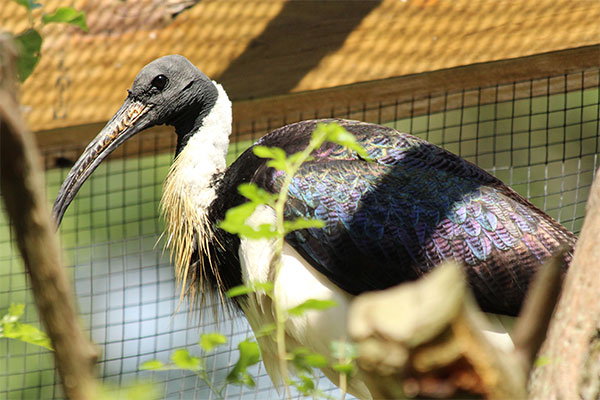
Habitat:
Straw-necked ibises live in Australia, Indonesia, Papua New Guinea, Norfolk Island and New Zealand, in forests, grasslands, and artificial terrestrial and aquatic areas.Adaptations:
These animals move around a lot.Diet:
Straw-necked ibises eat insects such as grasshoppers and locusts. They can also eat small animals including frogs, snails, reptiles and more.Fun Fact:
This animal gets its name from the straw-like feathers on its neck. This bird's nickname is the "Farmer's Friend" because of the insects it likes to eat.Status:
IUCN Red List Status: Least ConcernTawny Frogmouth
Podargus strigoides
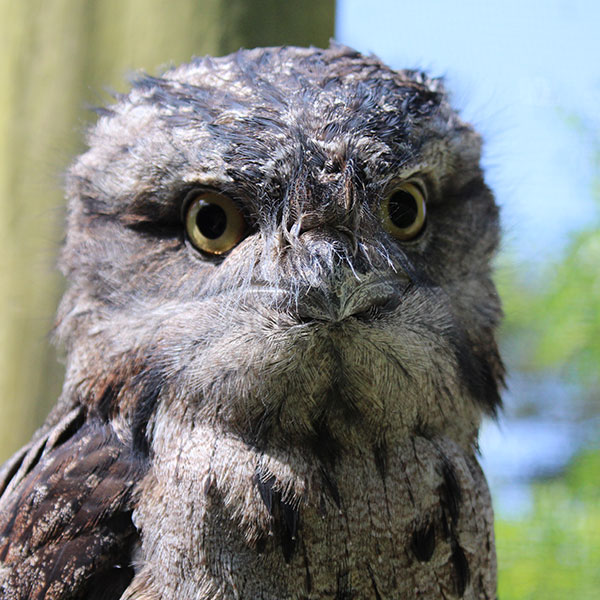
Habitat:
The tawny frogmouth is found throughout Australia, including Tasmania. This species can be seen in almost any habitat type except the denser rainforests and treeless deserts.Adaptations:
Tawny frogmouths may have been named because of their tawny-colored plumage with dark streaks, which gives them excellent camouflage. At the hint of threat or disturbance they freeze, compacting their plumage to disguise themselves as a broken branch. During the winter, they save energy by going into torpor, during which they lower their heart rate and metabolism.Diet:
Tawny frogmouths eat insects, worms, snails, small mammals, reptiles and frogs. Frogmouths hunt from perches, pouncing onto the ground to grab prey. They will sometimes sit with their mouths open, snatching up insects that fly into their beak.Fun Fact:
Though they don’t move much, frogmouths can be very talkative. When danger approaches, adults will give an alarm call to their chicks, telling them to stay still. Males and females often sing drumming duets to one another.Status:
IUCN Red List Status: Least ConcernThe biggest threats that they face are road accidents as they go to feed on insects that are attracted to car headlights.
Wood Duck
Aix sponsa
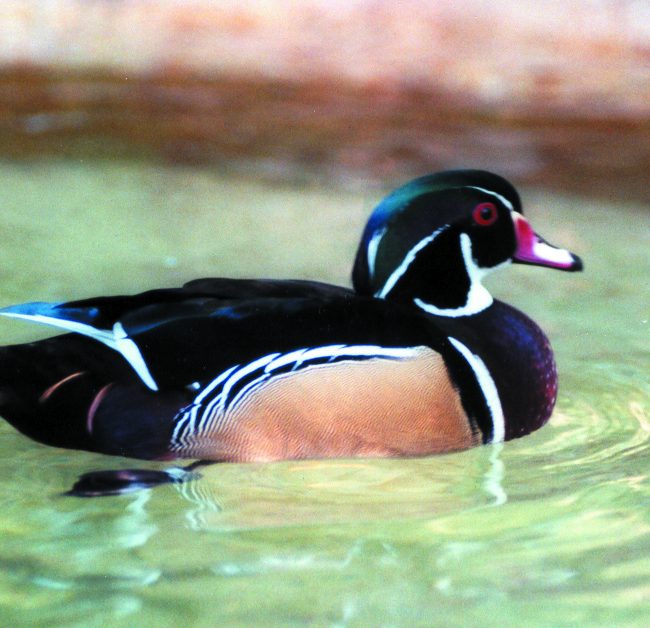
Habitat:
Wood ducks can be found from Canada to the southeastern United States. They prefer wooded wetlands, streams, and small lakes.Adaptations:
Unlike many ducks, wood ducks have clawed feet, which help them perch on tree branches. They are also more vocal than many ducks, possibly an adaptation to help wood ducks stay in touch in dense vegetation.Diet:
They eat seeds, fruits, insects, acorns and small fish.Fun Fact:
Wood ducks are the only North American duck to regularly raise two clutches of eggs a year. It is not uncommon for females to lay their eggs in the nests of other ducks.Status:
IUCN Red List Status: Least ConcernWood ducks declined sharply in the early 1900s due to overhunting and habitat loss. The species has since rebounded, largely due to the provision of human-built nest boxes to replace the large trees they used to nest in.
Alpaca
Lama pacos
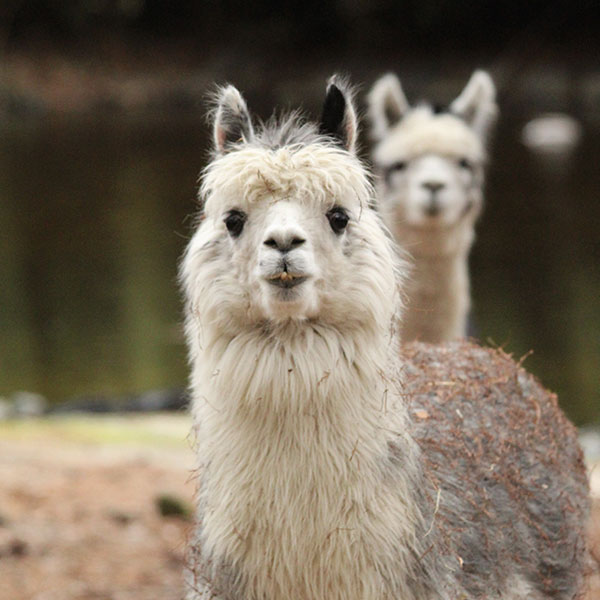
Habitat:
Alpacas are a domesticated member of the camel (camelid) family, which also includes the llama, guanaco and vicunas from South America. Alpacas were domesticated from the vicuna by the Incas more than 5,000 years ago and are among the most ancient of the world's domestic animals.Adaptations:
Alpacas are raised for their exquisite fleece, which comes in many colors. Their dense coat keeps them warm in the cold climates. They are herd animals. Alpacas are agile climbers and have been used to haul items up and down mountains. They are very alert, with excellent eyesight.Diet:
Hay and grassesFun Fact:
A baby alpaca is called a "cria." A female is called a "hembra" and a male is called a "macho."Status:
Alpacas are a domesticated species and do not exist in the wild. However, they are becoming more popular as pets and can be found on farms and ranches throughout North America.Andean Bear
Tremarctos ornatus
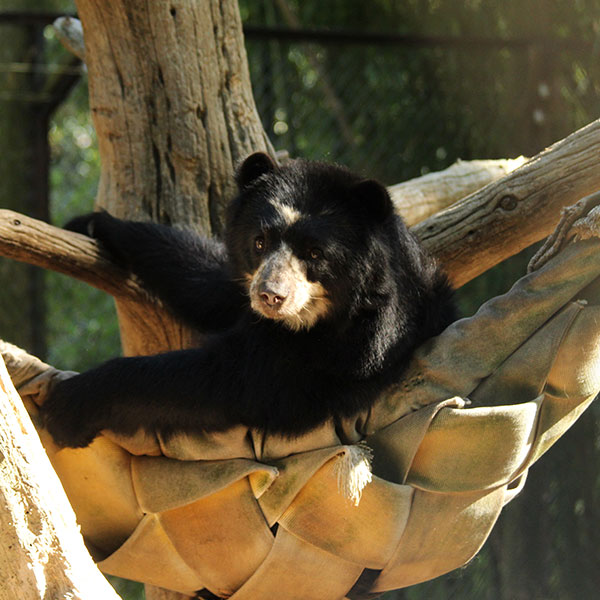
Habitat:
Andean bears live in the mountainous regions of western Venezuela, Columbia, Ecuador, Peru and western Bolivia. They are found in a variety of habitats, including scrub desert and grassland, but are most often associated with the cloud forests high in the Andes Mountains.Adaptations:
The Andean bear is also known as the spectacled bear, because of light coloration around the eyes that resembles spectacles, or glasses. They also have cream-colored markings on the muzzle and chest. Markings vary considerably -- no two bears have the same pattern. One of the smaller bears, Andean bears measure five to eight feet long, and they can weigh up to 300 pounds. They are excellent climbers and may build tree nests, where they will sleep during the day. They come down to forage at night.Diet:
Andean bears are one of the most herbivorous (plant-eating) of bears, with less than 10% of their diet consisting of meat. The majority of their foods are fruit, seeds, leaves, palm sprouts, bromeliads and bamboo hearts.Fun Fact:
The Andean bear is the only bear native to the continent of South America. Female Andean bears are much smaller than males, usually half the size. If a female bear meets a male bear and feels threatened, she will take advantage of her lighter build and run up into the trees, where the male will be too big and clumsy to follow.Status:
IUCN Red List Status: Vulnerable Their habitat is disappearing due to increased deforestation to support agriculture.Black-Handed Spider Monkey
Ateles geoffroyi
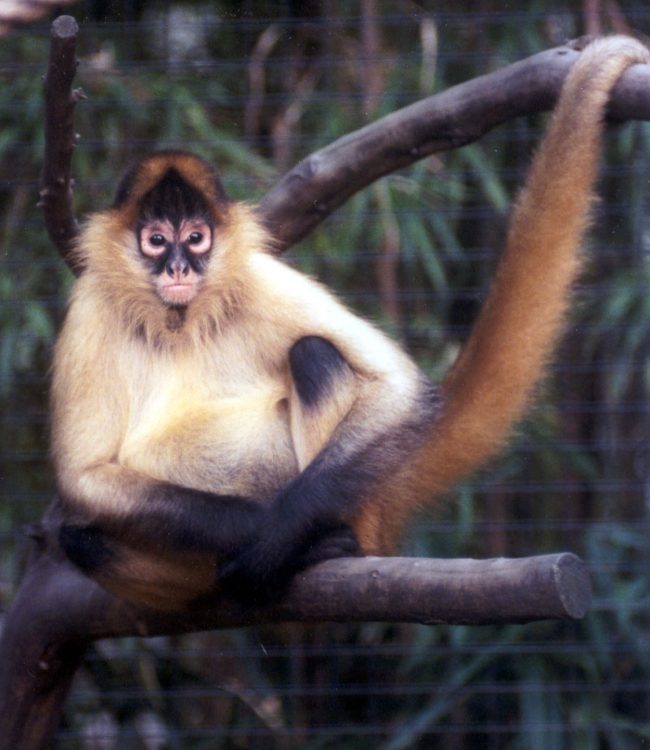
Habitat:
Black-handed spider monkeys live in the rainforests in southern Mexico, high among the branches in the forest canopy. They live almost entirely in the trees, rarely descending to the ground.Adaptations:
Spider monkeys are amazing acrobats, and their entire body is geared towards climbing. Their most notable feature is the prehensile (hand-like) tail, which they can use as an extra limb while climbing. Equipped with a naked patch at the end for improved gripping, the tail can be used to reach out for branches, steady the monkey’s weight, or even pick up objects. The elongated arms and legs increase the monkey’s momentum as it swings through the trees, arm over arm, reaching speeds up to 15 miles per hour.Diet:
This species eats fruits, leaves, nuts, insects, arachnids and eggs.Fun Fact:
The name “spider monkey” refers to how the monkeys look like spiders when they hang from their tails with all four limbs extended. Spider monkeys live in social groups made up of approximately 30 individuals.Status:
IUCN Red List Status: EndangeredBlack-Tailed Prairie Dog
Cynomys ludovicianus
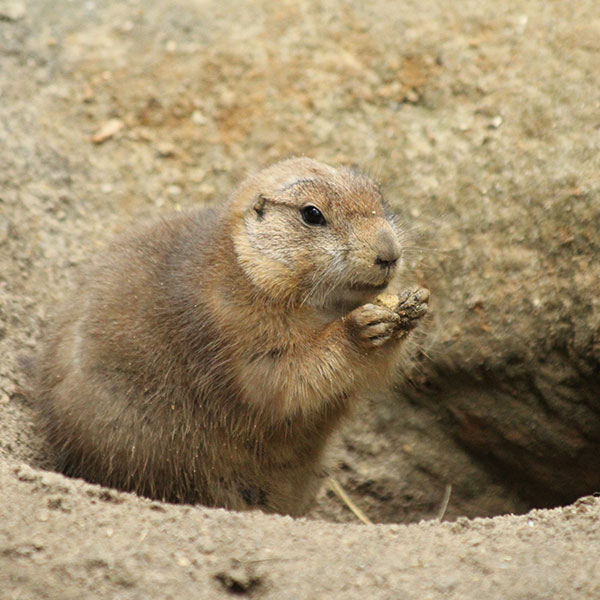
Habitat:
Prairie dogs can be found in the Great Plains area of the central United States. They live in a series of underground burrows. The burrows are an interconnected series of tunnels and chambers, consisting of several different rooms and more than one entrance.Adaptations:
Prairie dogs are territorial. Group members announce the boundaries of their territory by rearing up on their hind legs, pointing their heads skyward, and giving a series of distinctive barks. The prairie dog maintains its social structure with a ritual of kisses.Diet:
Grasses and other plants, including crops such as alfalfa and corn.Fun Fact:
Despite their name, prairie dogs aren’t dogs – they are squirrels. Their name comes from the barking noise that they make to warn one another of danger.Status:
IUCN Red List Status: Least Concern Prairie dogs have seen a tremendous reduction in their numbers over the past century, the result of hunting and poisoning. Many farmers viewed them as competitors with their livestock. The disappearance of prairie dogs greatly impacts their ecosystem. Several other species make their homes in prairie dog burrows, including snakes, owls, and toads.Predators:
Many predators eat prairie dogs; one, the critically endangered black-footed ferret, eats little else.Black-Tufted Marmoset
Callithrix penicillata
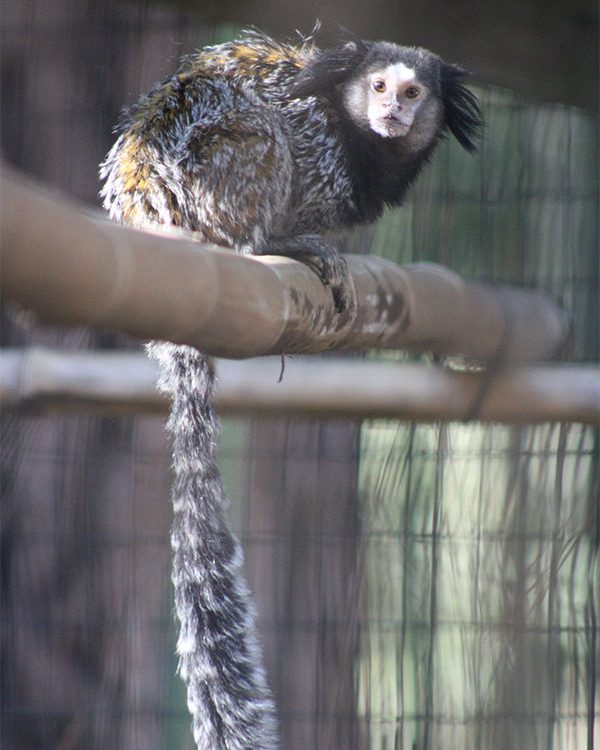
Habitat:
Black-tufted marmosets are native to South America, mainly Brazil. They live in the canopy of the rainforest.Adaptations:
These animals are arboreal and almost never go to the ground.Diet:
In the wild, they eat tree sap and gum, insects, fruit and small invertebrates. In the zoo, they are fed tree gum, insects, vegetables, fruit and canned food made specifically for marmosets.Fun Fact:
A black-tufted marmoset only weighs about as much as a full can of soda.Status:
IUCN Red List Status: Least ConcernCanada Lynx
Lynx canadensis
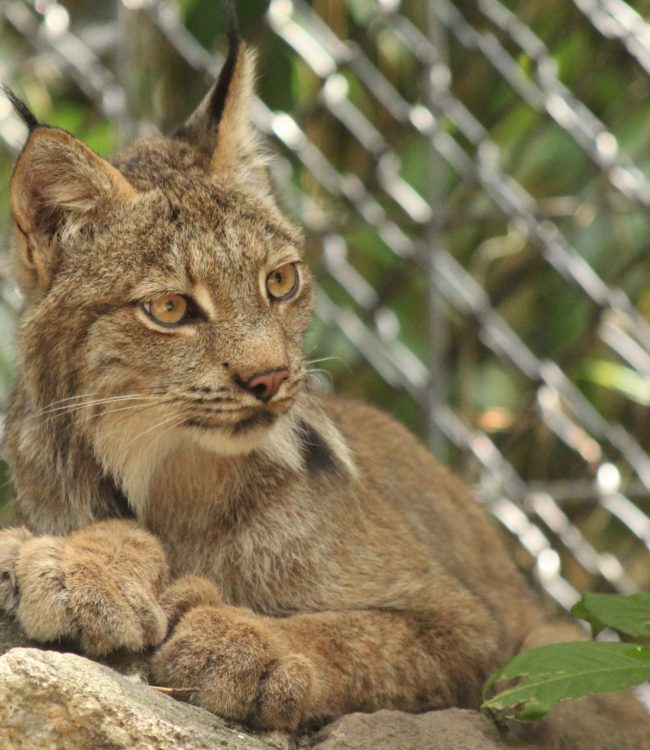
Habitat:
Canada lynx live in much of Canada, in Alaska, and in other small portions of the northern United States. They can be found in forests, grassland and shrubland.Adaptations:
The animals' large broad feet serve as built-in snowshoes, and they can be recognized by their black ear tufts and black-tipped tail. They are good climbers.Diet:
In the wild, they mainly eat snowshoe hare. If they can't find that, they will eat other animals.Fun Fact:
On a regular day, a Canada lynx will travel one to five miles.Status:
IUCN Red List Status: Least ConcernPredators:
Wolves and coyotesCapybara
Hydrochoerus hydrochaeris
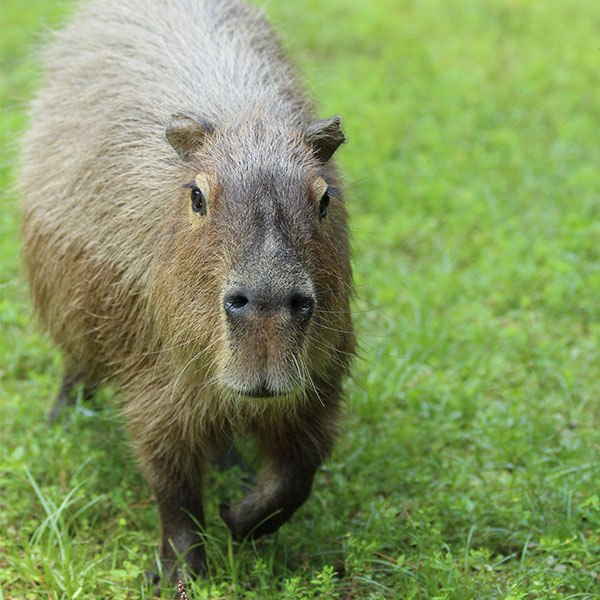
Habitat:
Capybaras live in family groups or small herds of 20 or less near lakes and rivers in South and Central America. Capybaras rest in shallow depressions in the ground.Adaptations:
The world’s largest rodent, the capybara can stand over two feet tall at the shoulder and weigh in excess of 120 pounds. They are sometimes referred to as “water hogs," both because of their pig-like appearance and because they spend considerable time in the water. They are crepuscular (active at dawn and dusk). They are graceful swimmers, having partially webbed feet, and can remain submerged for several minutes. A large amount of fatty tissue gives them neutral buoyancy in the water.Diet:
Capybaras may graze on land or feed on hyacinth and other aquatic plants in the water. Like other rodents, their teeth grow continuously and must be worn down by gnawing.Fun Fact:
The word capybara means “master of the grasses.” Centuries ago, capybaras were declared to be a fish by the Pope, which allowed the meat to be eaten during the Lenten season.Status:
IUCN Red List Status: Least ConcernPredators:
Jaguars, puma, caiman, anacondas and humans.Cotton-Top Tamarin
Saguinus oedipus
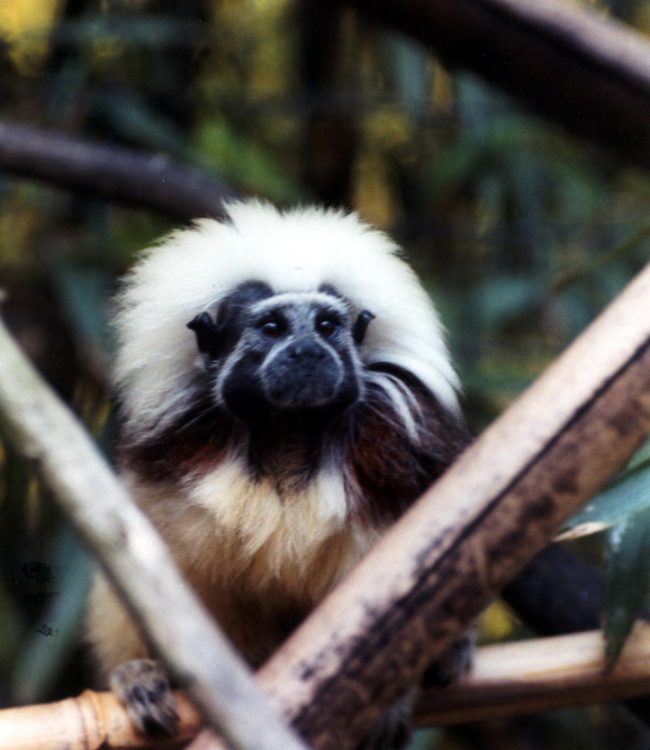
Habitat:
Found in northern Colombia, cotton-top tamarins inhabit tropical forests, including wetlands and dry thorn forests.Adaptations:
Cotton-top tamarins communicate using their facial expressions, postures, hair reaction and high-pitched vocalizations. Acute eyesight, hearing and smell aid in hunting and in detecting danger. Their long tails help keep balance while jumping and climbing, though they cannot swing or grasp with their tails like many South American monkeys can.Diet:
Tamarins feed on fruit, insects and bird eggs. They obtain their drinking water by licking rain or dew off of leaves.Fun Fact:
A tamarin family consists of a mated pair and their offspring, who stay with their parents to help them raise the next set of young. After the female gives birth, she often passes the babies (usually twins) over to the father or one of her older children to carry. This frees her up to find the food she needs in order to produce milk. Cotton-top tamarins make at least 38 different types of sounds.Status:
IUCN Red List Status: Critically Endangered Tamarins are disappearing due to habitat loss caused by deforestation. They are also illegally captured for sale biomedical research.Linnaeus’s Two-Toed Sloth
Choloepus didactylus
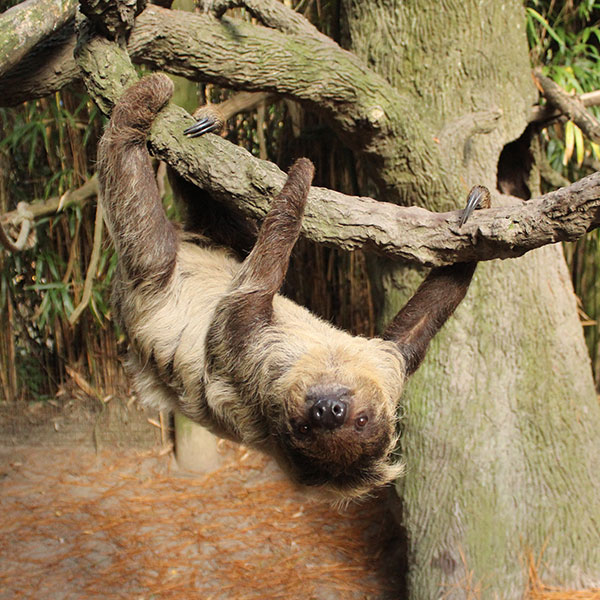
Habitat:
Two-toed sloths inhabit the rainforests of northern South America. They spend their lives in the treetops, only rarely descending to the ground.Adaptations:
The sloth is a nocturnal, solitary, slow-moving animal that eats, sleeps, breeds and nurses its young while hanging upside down. The two-toed sloth has forelimbs that have two claws bound together with skin, while the hind limbs have three. These feet provide a safe, powerful grip on the branches where the sloth hangs for much of its life. Unable to move quickly, sloths rely on camouflage to protect themselves from eagles and other predators. But not moving, they attract little attention; sloths are so stationary that algae will even grow in their fur, helping them blend in among the leaves.Diet:
Sloths eat leaves, shoots and fruit.Fun Fact:
As slow as they are in the trees, sloths are helpless on the ground. On the rare occasions when they must travel on the ground, they cannot walk and must drag themselves on their bellies using their claws. They are, however, excellent swimmers. When the forest canopy is interrupted by a river or lake, sloths often paddle to new feeding grounds.Status:
IUCN Red List Status: Least ConcernNigerian Dwarf Goat
Capra aegagrus hircus
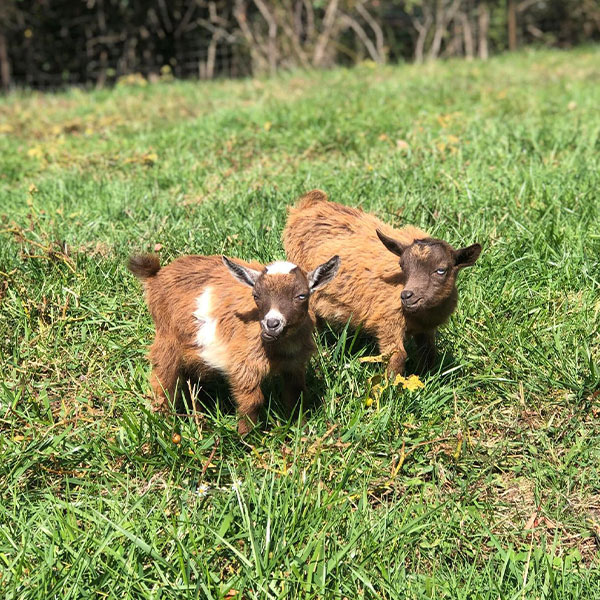
Habitat:
West African dwarf goats were brought to the United States in the twentieth century. The Nigerian dwarf goat has been domesticated and can live in a variety of climates.Adaptations:
Zoos have helped in breeding these animals in the United States.Diet:
Nigerian Dwarf Goats eat hay and plants.Fun Fact:
These goats produce sweet, fatty milk. This breed is shown at American Goat Society and American Dairy Goat Association shows.Status:
This breed's population has increased over the years.North American Beaver
Castor canadensis
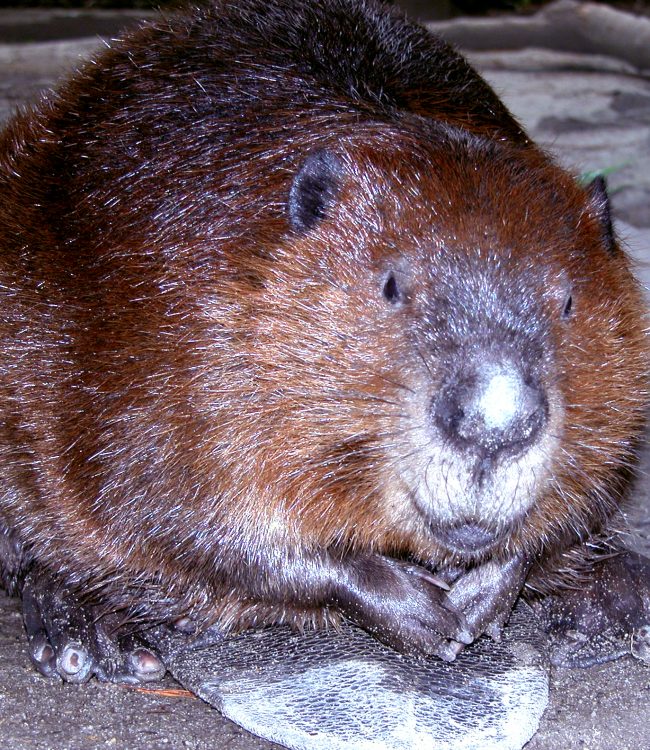
Habitat:
Beavers are found in North America in streams and lakes that have trees or shrubs on the banks. Unlike many animals, beavers will make their own habitat, using downed trees, mud and rocks to form dams, which blockade streams to form ponds. These dams can measure up to half a mile long.Adaptations:
As a semi-aquatic species, the eyes, ears and nose are located on the top of the head. This allows the animal to see, hear and breathe while the rest of its body is submerged. The eyes have a transparent (nictitating) membrane that covers the eyes while underwater. The large hind feet are webbed for swimming. The mouth has extra “lips” that close behind the incisors to allow chewing underwater. The tail is broad and flat and is used as a paddle when swimming and for balance on land. If frightened, a beaver will slap the surface of the water with its tail, sounding an alarm.Diet:
Beavers eat leaves, twigs, the inner bark of trees, ferns and skunk cabbage. In the autumn, beavers cut and gather young saplings. They stockpile them near the lodge until they sink from the weight of the pile. This stockpile will be a source of fresh food during the winter months.Fun Fact:
During the colonial era, beaver fur was one of the most valuable trade items in the Americas. One of the main driving forces behind the exploration of North America was the search for more beaver pelts, and wars were fought over access to beaver-rich lands. Heavy hunting pressure caused beavers to disappear from much of their range, though they have since become more common.Status:
IUCN Red List Status: Least ConcernNorth American Bison
Bison bison
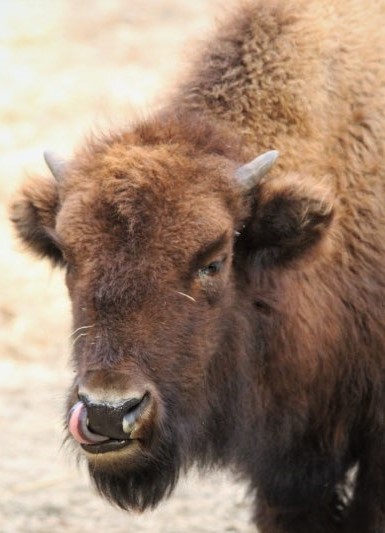
Habitat:
Historically, bison were found from Alaska southward to northern Mexico. Today, they occupy a patchy distribution on public and private lands on the prairies of western North America.Adaptations:
Bison are approximately six feet tall, up to 11 feet long, and weigh over 2,000 pounds, making them the largest land animal in the western hemisphere. The shaggy, brownish-black fur is shed in the summer, revealing a shorter coat underneath. The large hump on the back is used to support the massive head, which in turn is used to clear snow away from hidden grasses.Diet:
Grasses, shrubsFun Fact:
While they are often called “buffalo,” the true buffalo are found in Africa and Asia. Although bison have sharp senses of smell and hearing, they have poor vision. Despite their great bulk, bison are capable of running more than 30 miles an hour for an extended period of time. In 2016, the American bison was designated the national mammal of the United States of America.Status:
IUCN Red List Status: Near ThreatenedOcelot
Leopardus pardalis
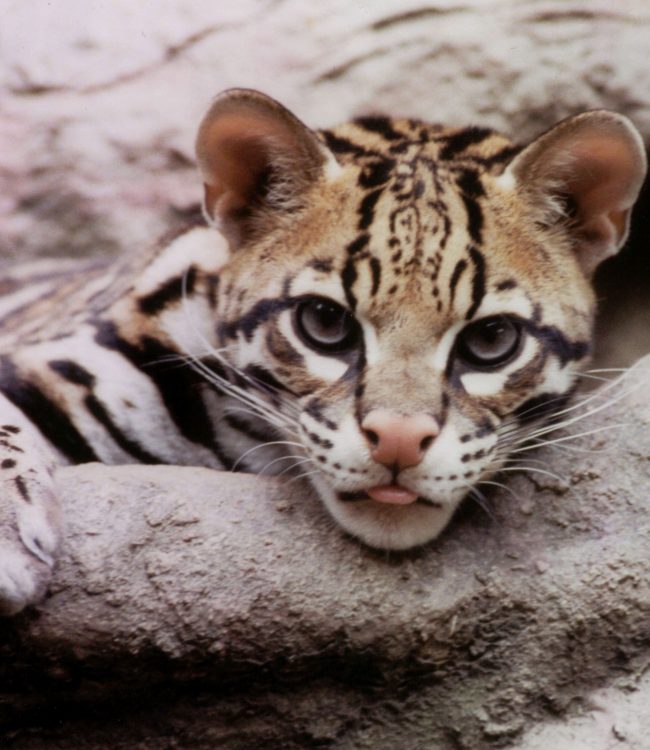
Habitat:
Ocelots live in the tropical forest, brushwood and rocky regions of Central and South America. Active by night, they spend their days resting among trees or in hidden dens.Adaptations:
The striped and spotted fur of the ocelot provides excellent camouflage among the broken shadows and patchy sunlight of the forest floor. Solitary hunters, ocelots will hunt on the ground or in the trees, and they can catch prey in one of several ways – actively foraging, stalking prey or lying in ambush.Diet:
Ocelots feed on small mammals, such as rodents, armadillos and small monkeys, as well as birds, reptiles, fish and crabs. They will occasionally take larger prey, such as small deer.Fun Fact:
The fur is accented with open-center dark spots that run in horizontal lines, resulting in a striped pattern. No two ocelots have the same pattern.Status:
IUCN Red List Status: Least ConcernRed-Necked Wallaby
Macropus rufogriseus
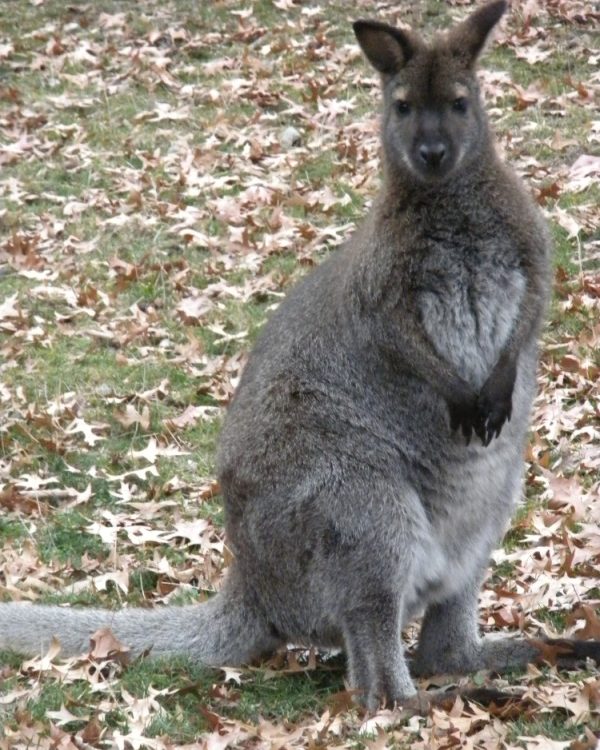
Habitat:
Red-necked wallabies are found in eastern and southeastern Australia, as well as the island of Tasmania. They inhabit grasslands and the edges of forested areas. This species has been introduced to New Zealand.Adaptations:
Wallabies are mainly crepuscular (active at dawn and dusk). They have large hind feet and use these, their tails and their front legs to walk. If startled, they will hop rapidly away on the hind feet. They can go up to 30 mph, and can leap four to six feet high. They have thick, coarse hair and long tapered tails, which are used for balance.Diet:
Wallabies eat grass, herbs, tree leaves, bark and fruit.Fun Fact:
A baby wallaby is called a joey. A joey will remain in its mother’s pouch until it is about 9-10 months old.Status:
IUCN Red List Status: Least ConcernRed Wolf
Canis rufus
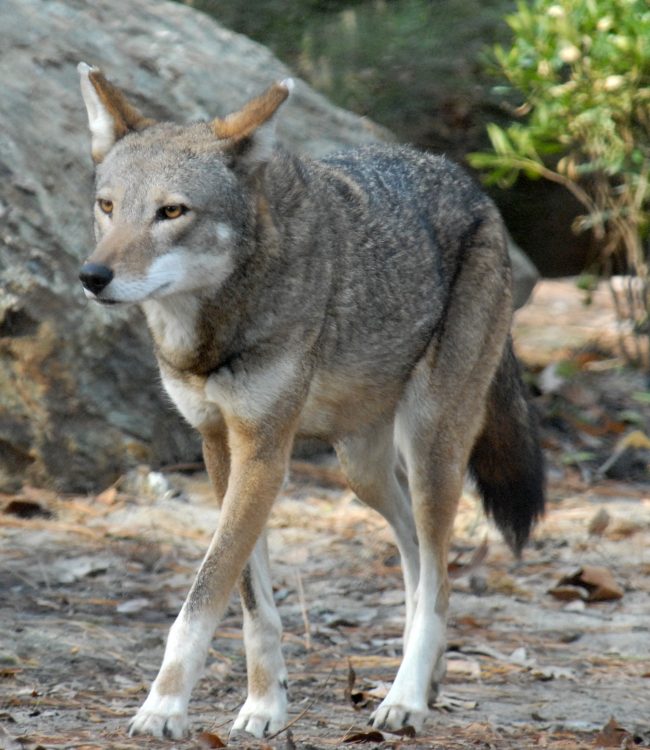
Habitat:
Red wolves once inhabited swamps and forests throughout the southeastern United States. Today, wild red wolves are found only in eastern North Carolina, at the Alligator River National Wildlife Refuge and surrounding lands.Adaptations:
Red wolves get their name from the reddish-brown color of their coats. Their ears are tall and pointed and they have long legs with big feet. They are about 26 inches tall and, when full grown, they are about four-and-a-half feet long. Adults weigh anywhere from 45-80 pounds, with males often being heavier than females.Diet:
Red wolves eat rabbits, raccoons, nutria and deer.Fun Fact:
Red wolves live in packs, usually made up of one breeding pair and their offspring. They are primarily active at dawn and dusk.Status:
IUCN Red List Status: Critically Endangered By the 1970s, red wolves were driven to extinction in the wild by habitat loss and direct persecution. All that remained was a population in zoos. Captive breeding saved this species from extinction, and a small population has been reintroduced into the wild in eastern North Carolina. A major threat to the species has been competition and cross-breeding with the closely related coyote.White-Tailed Deer
Odocoileus virginianus
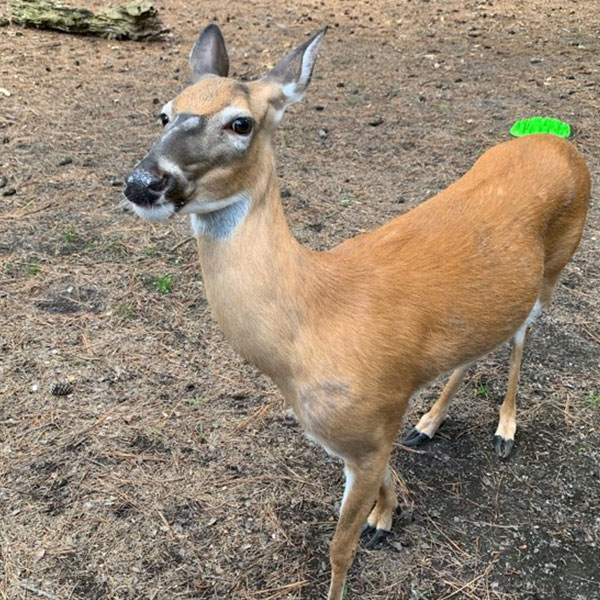
Habitat:
White-tailed deer are common throughout much of the United States, but their range stretches much further, from southern Canada down through South America. They are most common in edge habitats, where fields and meadows meet woodlands. They usually feed from late afternoon into the nighttime hours and are often back in the safety of their bedding areas by first light of morning.Adaptations:
The summer hair coat is reddish-brown, while the thicker winter coat is dull brown to grayish. Fawns are covered with white spots for camouflage. Deer use their excellent senses of smell, hearing and eyesight to detect predators. When danger is spotted, deer will flee, flashing their white tails as a warning sign to other deer.Diet:
Green plants, acorns and other nuts, tree buds, woody plants, shrubs and cultivated crops.Fun Fact:
Male white-tailed deer grow antlers, which they use to compete for access to females. After the breeding season, these antlers drop off, and are regrown the next year.Status:
IUCN Red List Status: Least ConcernGreen Plumed Basilisk
Basiliscus plumifrons
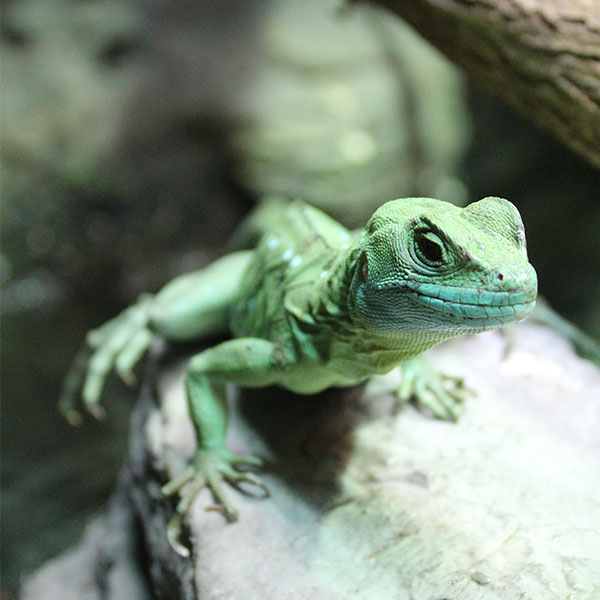
Habitat:
Green plumed basilisks live in forests and wetlands in Costa Rica, Honduras, Nicaragua and Panama.Adaptations:
Like other basilisks, they are able to run short distances across bodies of water to escape predators, using scales on their feet. This has given them their nickname of "Jesus Christ lizards." Males have large crests on their head, back and tail.Diet:
Green plumed basilisks eat insects, small animals and some plant material.Fun Fact:
It is possible for a green plumed basilisk reach a speed of more than 7 mph.Status:
IUCN Red List Status: Least ConcernMexican Spiny-Tailed Iguana
Ctenosaura pectinata
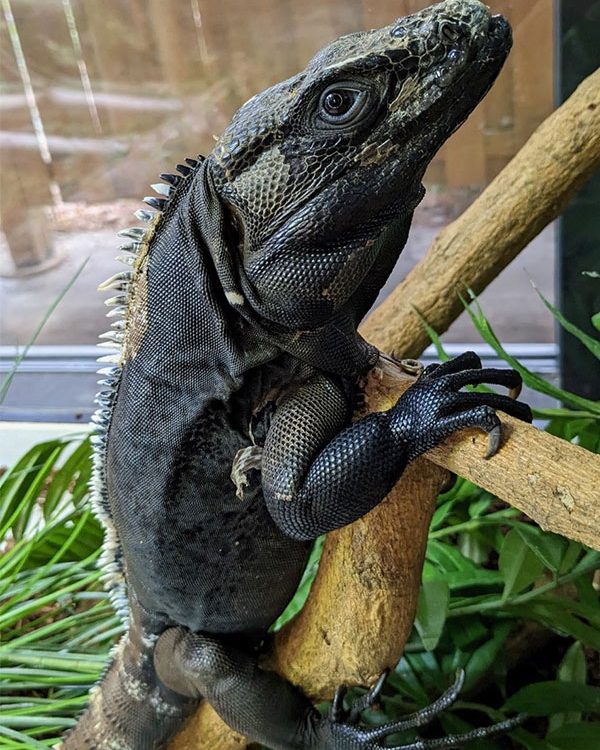
Habitat:
Mexican spiny-tailed iguanas can be found in Mexico, Texas and Florida. They are most often found on rocky outcroppings with plenty of crevices to hide in.Adaptations:
These animals are social, skilled at climbing and can move quickly when needed.Diet:
This animal eats greens, vegetables and fruits. Juveniles will also hunt insects.Fun Fact:
The Mexican spiny-tailed iguana gets its name from the keeled scales along its tail, which give the tail a spiny look.Red-Footed Tortoise
Chelonoidis carbonaria
Habitat:
Red-footed tortoises are native to moderate climates and have shown an ability to adapt to various climates and habitats in captivity.Adaptations:
Imported from the wild, red-footed tortoises are also farm-bred in large numbers in areas throughout South America. They are between 11 and 14 inches in length and grow mainly within their first five to 10 years of life.Diet:
They eat mixtures of fruits, vegetables, flowers and leaves.Fun Fact:
They can handle cold temperatures as low as 45 degrees without a problem. They can live more than 50 years.Spotted Turtle
Clemmys guttata
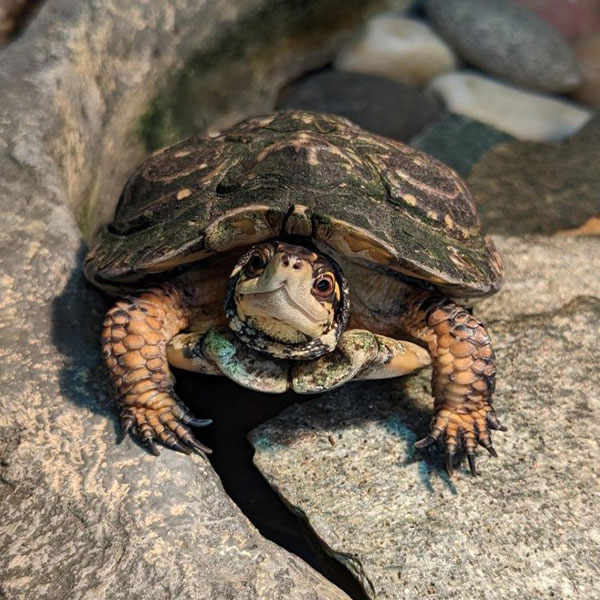
Habitat:
Spotted turtles can be found in all sorts of freshwater wetlands and rarely in brackish water. They are commonly found in areas with duckweed, which, with their spots, allow them to blend in. They range from Maine to northern Florida as well as the Great Lakes, the St. Lawrence River valley and the upper reaches of the Ohio River system.Adaptations:
Spotted turtles are semi-aquatic. Brumation, which is not quite hibernation but a rest period during a cold season, is common for these turtles when it is cold out.Diet:
In the wild, spotted turtles eat vegetation, fruit, algae, small fish and insects. At the zoo, they eat crickets, mealworms, earthworms and smelt (small fish).Fun Fact:
The spots they are known for cover their shells and can range in number from zero to more than 100. They have a large spot on both sides of their face; for males, it is darker, and for females, it is lighter.Status:
IUCN Red List Status: EndangeredYellow Anaconda
Eunectes notaeus

Habitat:
The yellow anaconda can be found in slow-moving rivers, marshlands and swamps in South America, including Paraguay, Bolivia, Uruguay, Western Brazil and Eastern Argentina.Adaptations:
These snakes mainly hunt in the water as an ambush predator, but they also hunt prey on land as well.Diet:
Yellow anacondas eat fish, reptiles, amphibians, mammals, birds and bird eggs.Fun Fact:
The yellow anaconda is not a venomous snake, and it suffocates its prey by constricting its coils. If anacondas capture prey in the water, the prey may drown instead.Status:
IUCN Red List Status: Least ConcernYellow-Banded Poison Dart Frog
Dendrobates leucomelas
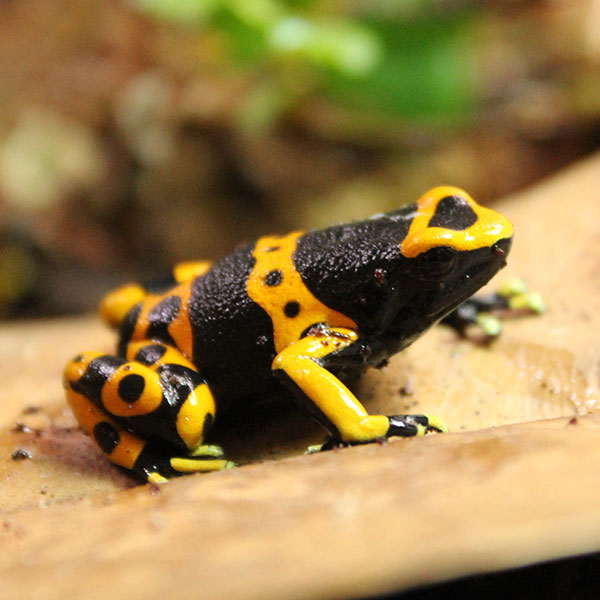
Habitat:
Yellow-banded poison dart frogs can be found in the rainforests of northern South America. Their preferred habitat is humid.Adaptations:
Yellow-banded poison dart frogs have bright yellow skin with black spots and bands covering their bodies. This coloration warns potential predators about consuming them. They are among the largest dart frogs, but will still only reach lengths of about two inches.Poison dart frogs secrete a toxin from their skin to deter predators from eating them. They get this toxin from a diet of insects in their natural habitat.





